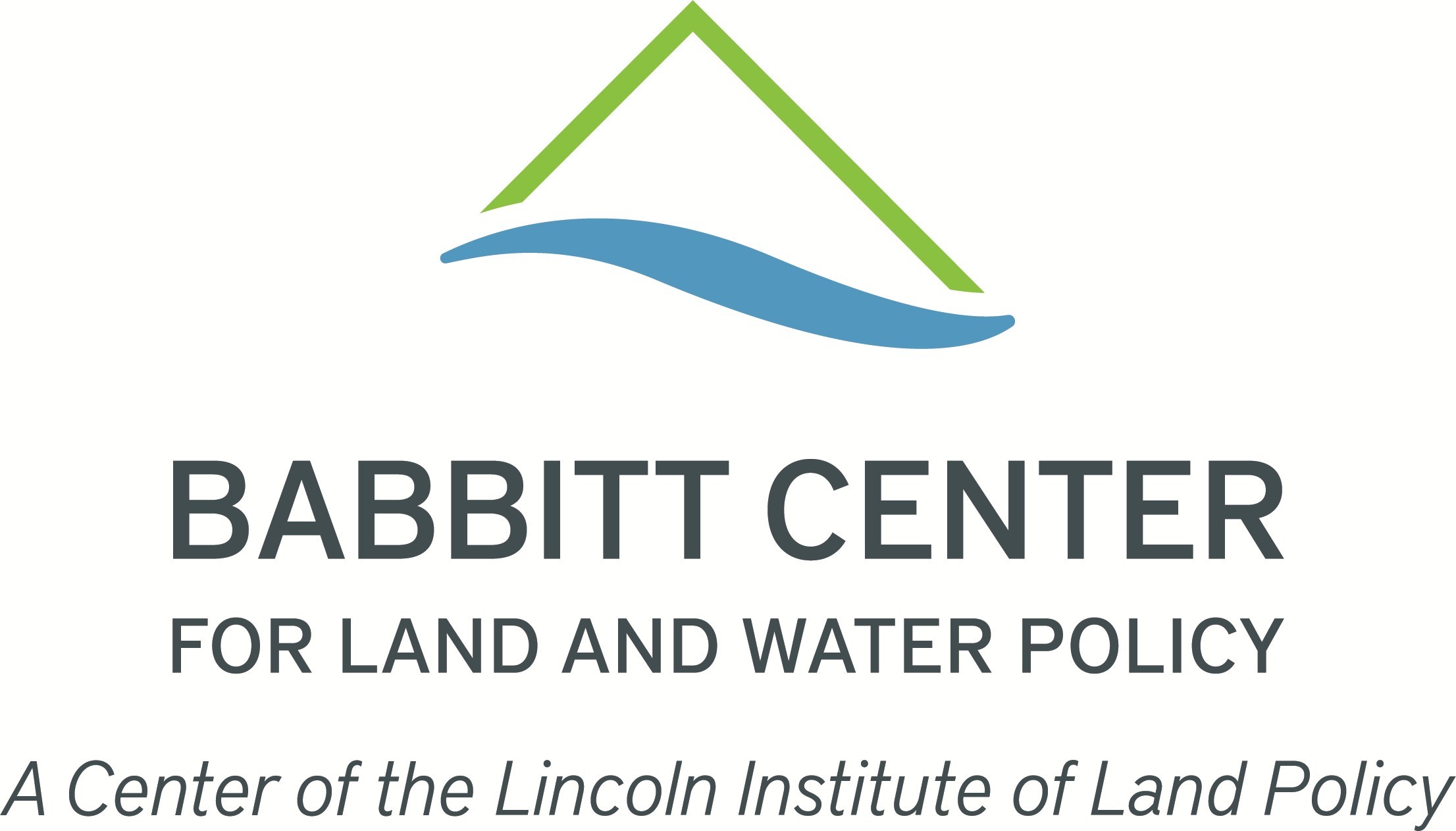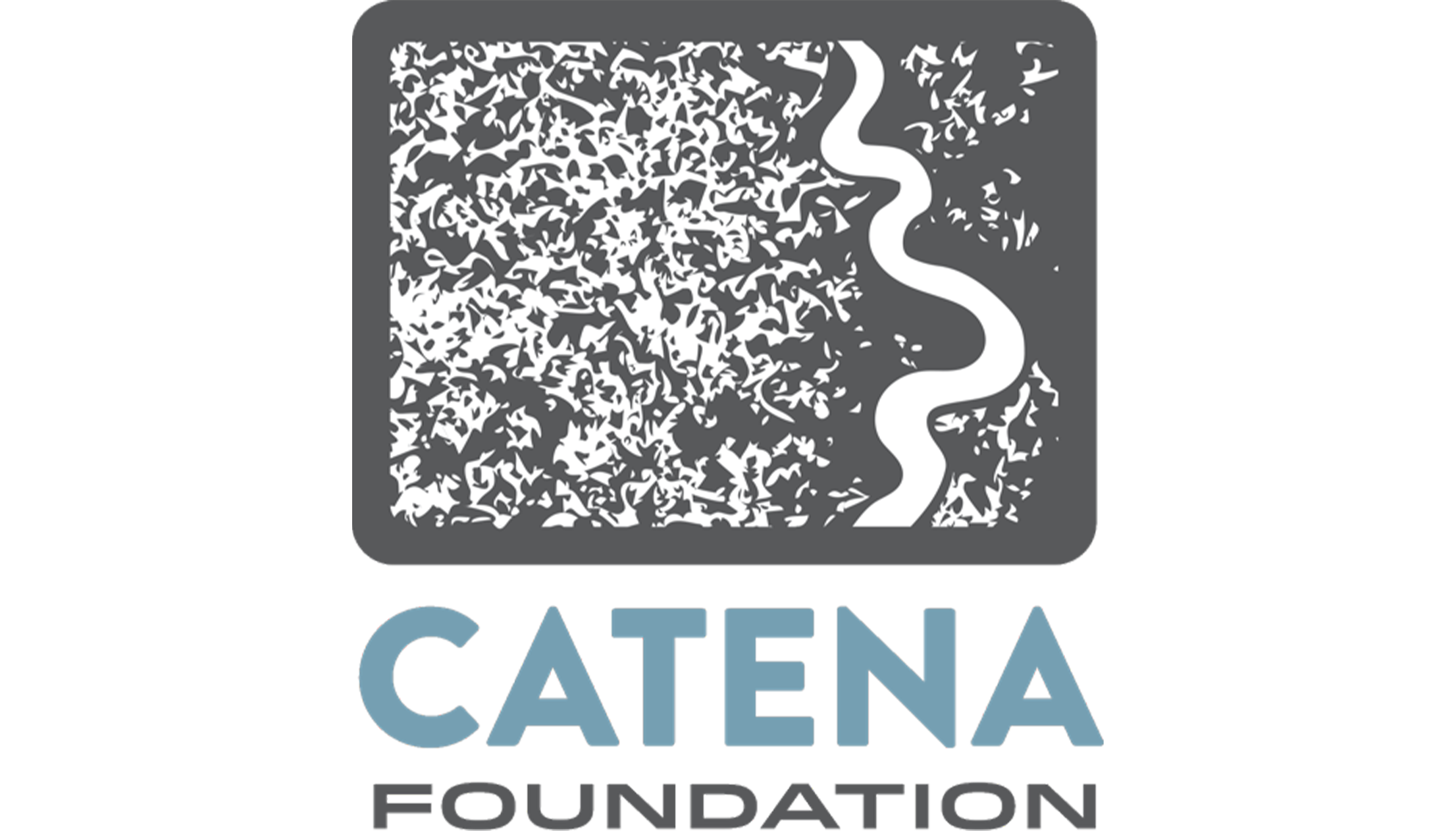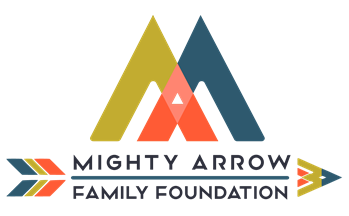ITEP Internships:

ITEP-EEOP Internship Program
321 S, Beaver, Bldg 7C
Northern Arizona University
Flagstaff, AZ 86001
Kim.Shaw@nau.edu



Meet our Interns
If you are a former ITEP intern, please contact ITEP to update your information. ITEP is interested in learning about your
current academic and/or career endeavors.
2023 Air Quality Summer Interns
Mariessa Fowler
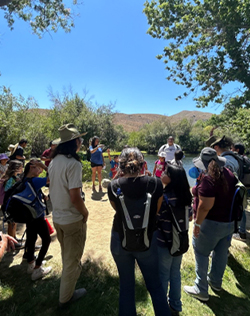 Mariessa Fowler
Mariessa FowlerBig Pine Paiute of Owens Valley Air Quality Internship
Big Pine, CA
The ITEP program was able to broaden my understanding of tribal affairs, educate me on the variety of environmental issues that different tribes face, and how important it is to have Indigenous people in the environmental field.
I had an amazing time with my mentors at Big Pine, CA and couldn’t have had a better experience. I was educated on air quality, native plants in California, the dust issues in Owens Valley, and other environmental issues that occurred in this area like groundwater pumping. I worked with many professionals who were passionate about their areas of focus and who were tremendous teachers. I was able to work with the tribal youth in different programs that involved gardening and outdoor reconnection. I was able to communicate with tribal members about their knowledge concerning air quality and what they wanted to see from the environmental department in the future. I also was fortunate enough to hear about Owens Valley’s Paiute history, culture, and teachings from elders or knowledge keepers.
My knowledge concerning native plants has expanded to a great extent and I am excited to apply all these details back home in my community. Not only did I learn a plethora of information regarding different subjects, but I also built lasting relationships and got to explore the beautiful landscapes across the Eastern Sierras. I was able to visit Yosemite when hardly anyone was in the park and was able to walk around with no vehicles. I also got to see the Ancient Bristlecone Pine Forest and visited Mono Lake. Not only did I get the scientific background on these places but the cultural history as well. The cross-cultural exchanges that occurred during this time were very eye-opening and incredible as well. I was able to understand how a smaller tribe operates and what kind of issues they face. I hope you join an ITEP program and are able to have phenomenal experiences.
Melayna Patton
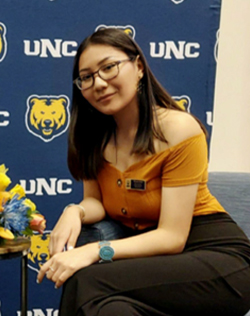 Melayna Patton
Melayna PattonNavajo Nation EPA - Air Quality Control Program
Fort Defiance, AZ
Yá’át’ééh! My name is Melayna Patton and I am a member of the Navajo Nation. For my internship experience, I had the special opportunity to intern for the Navajo Nation Environmental Protection Agency, under their Air Quality Control Program in Fort Defiance, AZ. Admittedly, before starting my internship, reading about the position was especially intimidating. I felt like transitioning into such a sophisticated, well-rounded work environment like NNEPA would be incredibly difficult. Not only because of the lack of experience I had with the environmental aspects of my Nation, but because of the responsibilities. that came with it. For the most part, I was frightened at the idea of not living up to what I could accomplish. But even so, I withheld that sentiment and applied for the internship, and I could say I will never regret it.
Undoubtedly, being here at NNEPA has accumulated to being the climax of my year. The staff have been welcoming and inclusive to me about learning their programs responsibilities and missions. As a result, in the course of two (2) months I have familiarized myself with their intent of protecting the health, environment and welfare of the Navajo Nation. I have also managed to appreciate their leadership in guiding me throughout the internship with informational reading sources regarding our duties of understanding environmental regulations and stability. Namely, understanding acts, reviews, and essential permits. But to briefly conclude my experience, I did end up living up to what I could accomplish and more. I became a better person and I have gained an immense amount of knowledge. Without a doubt, it was a shift in my surroundings, but I have gained so much experience in working with environmental regulations that I would have not known if I hadn’t joined. For this reason, I am thankful I did. It not only helped me increase my expertise in policy implications but also getting to know what obstacles my reservation faces. But to say the least, interning at ITEP is an educational opportunity I will never forget.
Tracey Begaye
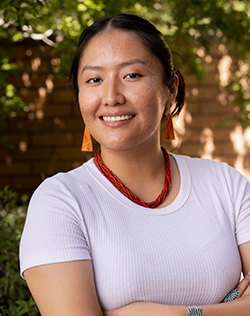 Tracey Begaye
Tracey BegayeFour Corners Science and Computing Club
(Flagstaff, AZ)
My name is Tracey Begaye. I am a part of the Navajo Tribe from Gallup, New Mexico. I had the pleasure of participating in ITEP’s Air Quality 10-week internship with the Four Corners Science and Computing Club (4CSCC). 4CSCC is a program focused on building awareness of and interest in computers in science. Their target audience is middle school through college students at schools primarily or largely serving Native American populations. The long-term goals of the program include increasing the representation and inclusion of Native Americans in open-source scientific computing.
I incorporated two sensor kits, the Raspberry Pi Pico and PMS5003, into a weather station set up for the workshops organized by 4CSCC. These sensors serve specific functions related to enhancing the capabilities of a weather station. I 3D designed a Stevenson Shield, an instrument shelter, to prevent damage to the power and air quality monitoring sensors that will be attached to a weather station. I had the exciting opportunity to collaborate with a weather kit that brings the wonders of scientific computing directly into the classroom. Notably, at the conclusion of each workshop, the computers and software are left in the schools, ensuring that students not only gain valuable experience but also pave the way for future generations to access these remarkable resources.
Seize ITEP summer internship opportunities to acquire valuable experience while simultaneously contributing to the betterment of Native American communities.
2023 Water Resources and Land Management Summer Intern
Colby Yazzie
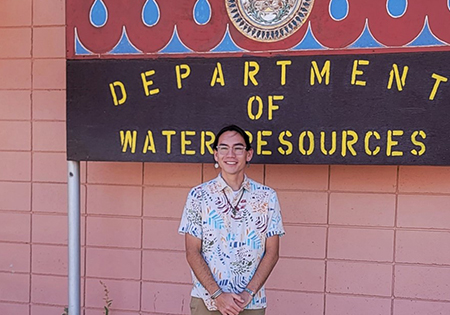 Colby Yazzie
Colby YazzieNavajo Nation Department of Water Resources - Water Management Branch
Fort Defiance, AZ
My name is Colby Yazzie. Ná’oolk’iłí Tsoh Bilagáana nishłí; Haltsooi’ bashishchiin; Tsíí’łichíí Bilagáana dashi cheiil; Nat’oh Dine’é Tachii’nii dashi nálí. I am from Sawmill, AZ. I am currently a rising senior at Cornell University where I am majoring in Animal Science with a concentration in applied animal biology and interdisciplinary studies. I am also minoring in American Indian and Indigenous Studies. However, my real study interests are in rangeland management/conservation and grazing practices of global Indigenous People. With this in mind, I applied to work with the Navajo Department of Water Resources – Water Management Branch to learn more about how water, in the forms of lakes and rivers, is managed in this high-elevation arid environment. To fully understand the status of the rangelands on the Navajo Nation, I think it is crucial to understand the water which hydrates these lands and the life forms on it.
While working with the Water Management Branch, I was fortunate enough to experience Lake Capacity Surveying, Lake Differential Leveling, various community outreach events, and Crop Inventory along the San Juan River. These projects have taught me invaluable skills in GIS software, data collection, and professional interactions with community members. The highlight of my internship at the Water Management Branch was being able to spend time and get to know the other interns. Being able to learn alongside these formidable individuals was inspiring. Long days in the office or the field, basically every day, allowed us to learn about each other on a personal level. We all have our own dreams and goals, but we share similar passions and strong motivations.
Malynndra Tome
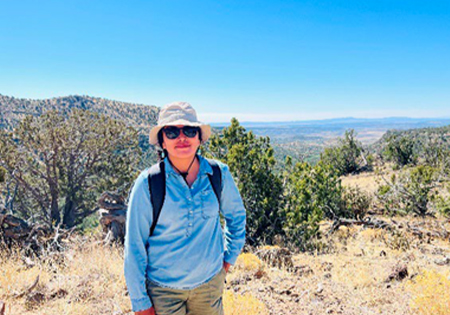 Malynndra Tome
Malynndra TomeNavajo Nation Department of Water Resources - Water Management Branch
Fort Defiance, AZ
Through the Institute for Tribal Environmental Professionals (ITEP) and its funders I was given the opportunity to work at the Navajo Nation Department of Water Resources – Water Management Branch.
This summer was spent assisting our supervisor complete projects concerning the management of the Navajo Nations water resources and to help quantify the Nations water resources for water rights activities. Projects such as Lake Capacity Surveying for lakes and reservoirs on the Navajo Nation, Differential leveling, and the annual San Juan River Basin Crop Inventory. We also assisted with the ongoing Westwater Project, to help bring water and electricity to the small Navajo community of Westwater in Utah.
These projects gave us a lot of ield work experience and lots of hands-on experience with ArcGIS mapping. It allowed us to work with other professionals within the department and other professional entities, as well as other interns, where we built great teamwork and communication skills. All of which helped us complete projects in a timely manner. It also gave us the opportunity to work with the communities and community members in which these projects were conducted.
I am thankful for this opportunity to develop my professional work experience and hope to take these skills on with me as I continue my education and one day my career in the environmental sciences.
Franklyn Telles
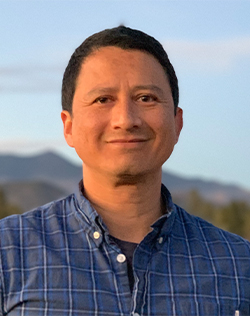 Franklyn Telles
Franklyn TellesU.S. Geological Survey
Tuba City, AZ (Virtual)
I enjoyed the collaboration and content development of education outreach materials and presentations at Tuba City Junior High School where most of the students are Navajo and Hopi. The collaboration occurred with the support of ITEP and the host site program from the United States Geological Survey, Reston, Virginia office of Youth and Education in Science and the facilities in Flagstaff, Arizona.
My hope is that future endeavors will include content development spearheaded by the Navajo and Hopi teachers. The purpose of this effort will make the content creation using indigenous ways of knowing and traditional knowledge so that students can learn more about their own culture and sacred places, and access the scientific knowledge available.
I highly recommend an ITEP internship. I learned a lot about working independently, collaborating online and in-person with other scientists and teachers, coordinating schedules, developing content, and sharing content knowledge to better understand the landscape with middle school students in a fun and engaging way.
Rene Castillo
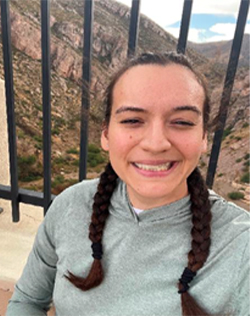 Rene Castillo
Rene CastilloSan Carlos Apache Tribe Department of Environment Protection
(Virtual)
Participating in an ITEP internship significantly contributed to my personal and professional growth, especially in the context of developing my role and identity as a scientist. My internship offered hands-on experience through partnership with the San Carlos Apache Tribe that complemented my academic knowledge with real world application, fostering a well-rounded and adaptable scientific perspective.
Throughout the summer internship I was exposed to real-world research scenarios and methodologies, enabling myself as an aspiring scientist to apply theoretical concepts in practical settings. This experience cultivates critical problem-solving skills that I have not done before through college alone. This internship facilitated collaboration with seasoned professionals, exposing me to diverse perspectives and approaches within my field. Engaging with mentors and colleagues allowed me to broaden my knowledge base, adapt to new techniques, and develop effective communication skills—a crucial aspect of scientific progress. The dynamic environment of an internship encouraged my adaptability and resilience.
My internship offered a chance to observe the broader context of scientific work, from project management and ethics considerations to the practical applications of research findings. Such exposure I feel fostered within me a holistic understanding of the scientific process, instilling not only technical proficiency but also an awareness of the ethical and societal dimensions of scientific endeavors. ITEP played an indispensable role in developing my journey as a scientist. The fusion of practical experience, collaboration, adaptability, and exposure to the multifaceted aspects of scientific work has equipped me with the skills and mindset necessary to excel and contribute effectively beyond the world of research to where it matters most, my personal goals and my community.
Brooke Damon
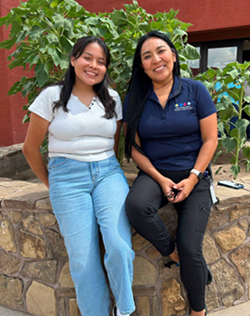 Brooke Damon
Brooke DamonHopi Tribe - Department of Natural Resources, Water Resources Program
Kykotsmovi, AZ
Yá’át’ééh, shí éí Brooke Damon yinishyé. Ta’neeszahnii nishłį, Tsin sikaadnii báshishchíín, Tábaahá dashícheii, dóó ‘Ashįįhíí dashínálí. Hello my name is Brooke Damon, I am of the Tangle People clan, born for the Clamp Tree clan, my maternal grandfather is of the Water Edge’s clan and paternal grandfather is of the Salt People clan. I am entering my final semester at Northern Arizona University majoring in Environmental Sciences with an emphasis in Biology and minoring in Chemistry. During my ITEP internship I was able to work with the Hopi Water Resources Program that is within the Department of Natural Resources. My main focus was on the data management of water quality from spring sites across the Hopi Reservation. I was able to attend site visits of areas that are subject to testing to provide insight and discuss spring restoration projects. I also was able to assist with other projects when needed and participate in different meetings that involved the Hopi Tribes.
Alexandria Ponce
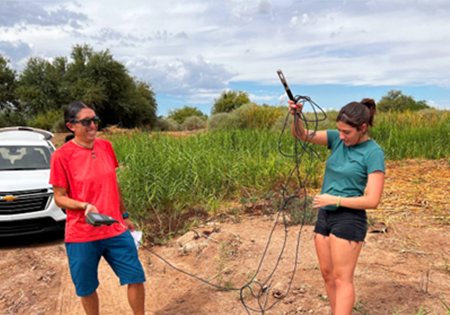 Alexandria Ponce
Alexandria PonceNorthern Arizona University- Cocopah Tribe Project
Yuma (Virtual)
Over the process of my internship, I was able to have a variety of experiences I had never imagined doing. As an anthropology major working with water sampling and learning about things like water treatment was not something I thought I’d ever do, but this internship gave me that chance. My internship focused on learning about the Cocopah Native American Tribe from their history to their relationship with water quality. I alongside my professor, Dr. Armando Medinaceli, are working with a group of environmental engineers to study the water quality on the Cocopah reservation and to make sure every step of this process is handled in the most culturally appropriate way.
The picture on the top left shows me holding a probe that I would toss into the water, and it would read different information on the state of the water. This information will be used to continue telling the tribe about the quality of their water. Later on, that same week I would also be given the chance to see the Mexican border that was placed in the reservation. The picture to the right was taken by me while in the truck that we had driven out there in. You can see to the left of the truck the metal border on the reservation and the wall on Arizona land next to it. Both features that impact the ability of the Cocopah to use and enjoy their own lands. This is all information that introduced me to an important topic, the struggles of reservations cut by a border, that I had never even considered before then. As well as an experience that I would not have had if the Cocopah were not as welcoming as they were or if I had not taken this internship.
Sydney Wilson
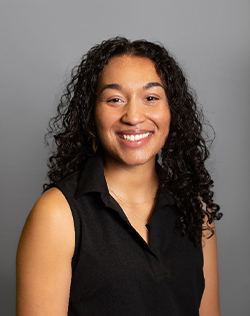 Sydney Wilson
Sydney WilsonNorthern Arizona University- Cocopah Tribe Project
Yuma (Virtual)
My internship with ITEP water and land was working in Dr. Diana Calvo’s lab at Northern Arizona University. Our project works with the Cocopah Tribe in Yuma, Arizona to assess the community’s current water quality for surfaces water, well water, and tap water. In this project, I worked to assess each water source for ten different water quality parameters. The ten water quality parameters are total nitrogen, total phosphate, chemical oxygen demand, alkalinity, total dissolved solids, dissolved oxygen, turbidity, temperature, conductivity, and pH. This summer my work included assessing the current sample locations for this uses in my project this Fall 2023, connecting with community council members, creating a list of protocols and methodology for sample collection according to source type, and drafting a sample plan to used in the Fall 2023.
My ITEP internship has been one of my favorite summers throughout my undergraduate career. ITEP allowed me to pursue my interests and continue to develop a project I feel connected to too. I was provided the resources I needed to succeed. I would strongly encourage all undergraduate and graduate students to apply for an ITEP internship if they are interested in environmental education or public health. The staff at ITEP supported me every step of the summer.
This fall I will continue my education at Northern Arizona University pursuing a master’s in environmental engineering. I appreciate the funding provided by ITEP to allow me to begin my master’s thesis off to a strong foundation.
Trisha Lane
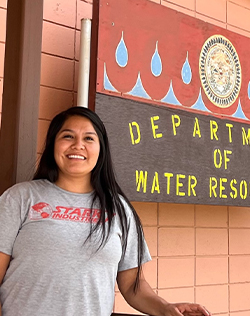 Trisha Lane
Trisha LaneNavajo Nation Water Management Branch
Fort Defiance, AZ
Yá’át’ééh, my name is Trisha Jean Lane. I am an undergraduate at the University of Arizona majoring in Environmental Engineering and minoring in Sustainable Built Environments. I had the pleasure of participating in ITEP’s Land and Water Summer 10-week internship with the Navajo Nation Water Monitoring Inventory (WMI). WMI is a program through the Navajo Nation’s Water Management Branch in Fort Defiance, Arizona.
The program's primary purpose is to monitor surface waters on the Navajo Nation, including activities such as drought monitoring, precipitation monitoring, climate stations, and stream gauging. The main objectives of the internship host site were to utilize the Drought Severity Evaluation Tool (DSET), an online remote sensing web tool, to apply various evapotranspiration (ET) drought indices for generating remotely sensed reports and explore best practices in utilizing ET as a drought index for the Navajo Nation's WMI program to assist with drought mitigation processes. As part of the internship, I was able to travel to the different parts of the reservation to gather precipitation data from rain gages in various agencies to assist with the data collection to attribute to the rainwater tables that could be used to create rain precipitation intervals to assist with drought monitoring and mitigation processes.
For the past two years, I have conducted environmental research in laboratories involving chemical properties and data analysis. I enjoyed doing field work and applying my current fluid mechanics and environmental engineering knowledge during the data analysis portion of the internship. Incorporating the skills I learned in my Remote Sensing and Watershed engineering courses made me feel on the right track with my career goal of becoming an Environmental Engineer.
Erin Begaye
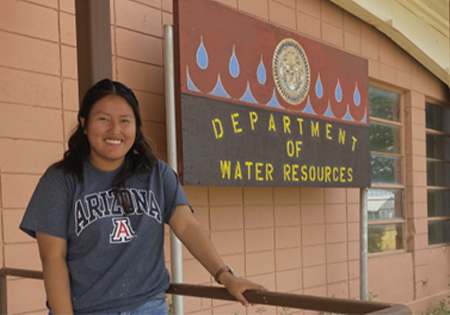 Erin Begaye
Erin BegayeNavajo Nation Water Management Branch
Fort Defiance, AZ
I was able to learn more about environmental issues on the Navajo Reservation and drought-related challenges because of my internship with ITEP. I traveled to various locations on the Navajo reservation for ten weeks while working with the Navajo Nation Water Management Branch to collect precipitation data to gauge the severity of the drought. I performed fieldwork, going to various locations with rain cans to take measurements. Additionally, I had the opportunity to collect precipitation data using the Drought Severity Evaluation Tool (DSET). Along with other interns, I worked with my supervisor, who provided guidance and assistance throughout the duration of our internship.
The pandemic led to numerous changes in the Navajo Nation Water Management Branch. During those times, there was a lot of missing data on precipitation measurements, and the interns, including myself, helped restore the majority of the data. Observing the team and entering precip measurements data into an Excel spreadsheet for tracking purposes were my daily tasks. I had no prior knowledge of precipitation data or rain cans before beginning my internship, but my supervisor taught me everything I needed to know during the brief time I was there. I gained a lot of knowledge about other environmental issues and how they relate to drought from this experience. Since I have no prior experience in the environmental field, my internship was an amazing chance to learn. I would advise anyone, regardless of background, to apply for this internship, to take advantage of the chance to learn more about the problems that tribal communities face. In order to address these issues, this program has further motivated me to pursue a career working with indigenous communities.
Zachary Beaver
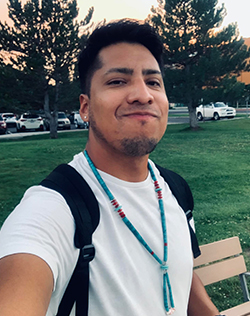 Zachary Beaver
Zachary BeaverNavajo Nation Department of Water Resources
Fort Defiance, AZ
My name is Zach and I am a Civil Engineer major at Northern Arizona University. After I graduate, I would probably like to attend graduate school at NAU. Ultimately, I would like to be a civil engineer on/off the Navajo reservation. The reason why I said "off the reservation" is to gain outside experience, but also to make relations with companies, organizations and people. A partnership amongst our neighbors is important. I am currently working with a hydrologist with the Navajo Nation Department of Water Resources (NNDWR) and I have learned so much information! I am looking towards an amazing future and I wish everybody well in their academic and professional endeavors. Ahehee'.
Caroline Reed
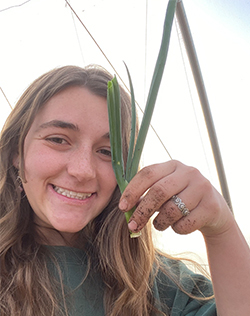 Caroline Reed
Caroline ReedCocopah Tribe
Northern Arizona University
My name is Caroline Reed, I am studying environmental engineering at Northern Arizona University. I spend a lot of times outdoors hiking, biking, climbing, and most anything else I can try. I also spend a lot of time in the garden, whether helping with maintenance or harvesting. I love cooking and baking, especially cinnamon rolls. I also love learning new things about language, so spend a lot of time doing word puzzles and reading.
As an environmental engineer, I hope to graduate with the knowledge to help with ensuring sustainable solutions for water engineering. I plan to stay for a masters of engineering at NAU, and hope that by completing a thesis I will become more aware of different water quality issues surrounding the state. Professionally, I hope to focus my work on water, specifically the conservation of water.
Through ITEP, I will be working with the Cocopah Tribe in southwestern Arizona to research their water quality. With this research, I will primarily focus on the microbial aspect of the drinking water.
Matthew Helms
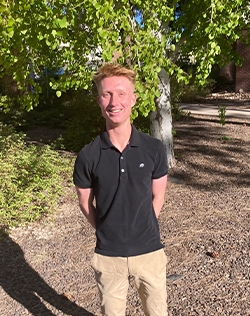 Matthew Helms
Matthew HelmsCocopah Tribe
Northern Arizona University
Matt Helms is a Northern Arizona University Student studying environmental engineering and chemistry. Matt is from Napa, California, he enjoys backpacking, skiing across the West, and long-distance running. He is currently involved in a research project at NAU in collaboration with a local Native American tribe, under the supervision of Dr. Diana Calvo. This project focuses on assessing the tribe’s water quality. His specific focus of this project is to determine the Nitrogen, Phosphorus, and Potassium nutrient concentrations and examine the microbial ecology of the water. Matt is planning on going on to graduate studies with a focus on water quality, microbial ecology, and nutrients in aquatic environments.
Nick Dawson
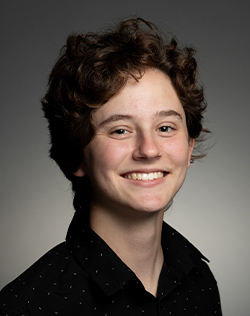 Nick Dawson
Nick DawsonCocopah Tribe
Northern Arizona University
Hello there! I am Nick Dawson, and I am a third year student at NAU studying Environmental Engineering and Mathematics. I am currently working with Dr. Calvo to assess the water quality of the water in underserved areas. When I graduate, I would love to work in water treatment so I am very happy to have the opportunity to learn more about water quality parameters and testing.
2022 Air Quality Summer Interns
Argen (Megan) Smith
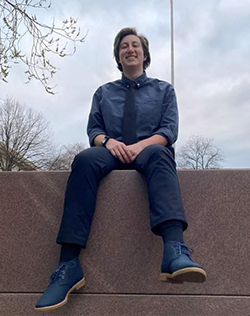 Argen (Megan) Smith
Argen (Megan) SmithEPA
Washington, D.C. (On-Site)
This summer, I researched the effects of climate change driven air quality impacts on Indigenous communities in the continental United States at the EPA in Washington DC.
I considered temperature driven ozone and PM¬2.5 as well as PM2.5 from wildfires. I was also hoping to include Southwest dust and valley fever, but the datasets were not specific enough to separately analyze the effects on federally recognized Tribal land. Ozone and PM2.5 are temperature, emission, and weather dependent, so a changing climate effects their pattern of concentration in the United States. A previous paper produced projections of ozone and PM2.5 out to 2095 using climate data from two global circulation models (GCMs). Because of increasing temperatures and changes to the hydrological cycle, wildfires are predicted to increase in size and area as the climate changes. Another paper produced projections of PM2.5 due to these growing wildfires out to 2090 using 5 GCMs.
Using this data, I estimated the health impacts using the Benefits Mapping and Analysis Program (BenMAP) and separated out effects to federally recognized Tribal land in ArcGIS. With this data, I calculated the statistical significance of the difference in impacts between Tribal land and land not recognized as belonging to Tribes. I found that air quality effects on asthma exacerbation, reductions in activity, upper respiratory inflammation, and lost workdays all impacted residents of Tribal land significantly more than the rest of the United States. The other goal of my project was simply to quantify the effect of climate change driven air quality related health impacts on Tribes in the continental United States.
In my research this summer, I was given full flexibility and support to learn and research what I was interested in. My advisors were incredible teachers and there were many resources available. I also enjoyed exploring the neighborhoods, parks, and museums in DC.
Camille Uentillie
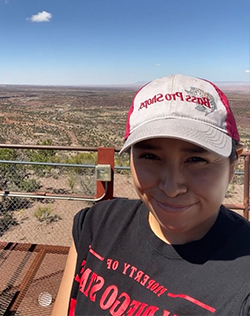 Camille Uentillie
Camille UentillieNNEPA- Air Quality Control Program
(Hybrid)
As I’ve completed my internship, I’m enrolled in my last semester as an undergraduate and the past few years, I have been learning much about the land and environment we live on. As a soon to be graduate with a degree but little experience in the environmental field, it can be overwhelming to find the right career. My internship with ITEP has been successful and opened my ideas with the many possibilities of what I could end up doing. I was not aware of the tribe’s departments, with air quality control program and operating permits program are a part a huge system that happens with global monitoring. Learning about the start and process of Operating Permits Program and Air Quality Control Program, I’ve understood both program work hard in hard to make sure air monitors are in great operation and facilities respect the air quality with the number of emissions they’re allowed to release. The employees explained with great details about regulations, their duties, and responsibilities to their program, and showing teamwork. My internship included researching about the air pollutants, understanding regulations the tribe has with the state, federal and government policies, traveling to check air monitors while replacing old filters with news ones and more.
I learned and grew from that past eight weeks interning under ITEP through the Navajo Nation tribe’s Air Quality Control Program and Operating Permits Program. Upcoming students considering internships with ITEP will have many questions, I assure you that your questions will be answered. The ITEP team will provide you the information from the start, throughout the end of the internship. My summer spent with the tribe taught me several things: the community elders love seeing students learning, understanding how the department works, a small community like AQCP and OPP cover a large portion of air monitoring. I saw the issues environmental issues occurring within the area and hope students know their passion for the land calls for environmental leaders. There are more opportunities coming up for OPP and AQCP, I hope to get to see student interns experience what the Navajo Nation and the other programs involving air quality has to offer through ITEP. I strongly recommend an internship with ITEP, I am happy with learning more about my tribe’s government and environmental department.
Clarene Davis
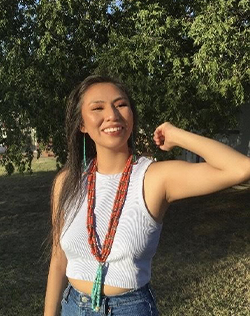 Clarene Davis
Clarene DavisEarth Gen
(On-Site)
My internship at ITEP provided me with numerous learning opportunities. I learned a lot about air quality and how climate change affects indigenous populations. Historically, tribes have played an essential role in environmental issues such as air pollution and climate change. I kept a weekly journal of my experiences, which I shared with my host site supervisor. I am pleased to report that I had an entire team of host relatives, two head supervisors, and coworkers assisting and guiding me with any assistance or guidance required during this internship.
I enjoy working with Earth Gen and Whiteswan Environmental since I work with a non-profit organization, and I am considering remaining connected and perhaps working with them in the future, as well as working with them on both of their social media platforms. I appreciate Earth Gen's encouragement in incorporating my own Navajo culture into the breathing easier curriculum by having me work on my graphic novel for the children's comics and explain air quality within my creators' narrative.
According to the EPA, tribal communities are more vulnerable to the effects of air pollution and have higher-than-average rates of diabetes, heart disease, and lung problems. Indoor air pollution has been related to a wide range of negative health impacts, including asthma, congestive heart failure, diabetes, and decreased cognitive performance.
My internship goals included communication assignments such as a PowerPoint presentation, brochure and video. In addition, I was a guest speaker for Whiteswan Environmental, where I discussed air quality with tribal property in Washington state. The most beneficial aspect of the learning experience, however, was the passion it inspired in me for the platform to work with Earth Gen, Moms Clean Air Forces, and Whiteswan Environmental, as well as the necessity for indigenous rights, particularly environmental justice for tribes.
Overall, I believe that this internship was effective in enhancing my understanding of a career in environmental science. I observed the stress of deadlines and the significance of being self-motivated. My host site supervisor is in charge of the academic subjects of my internship experience. This means empowering students in developing learning objectives, structuring academic reflection for the internship, and assessing student growth and learning. Earth Gen is urged to check my progress at the internship and to have strong communication on a regular basis, including dealing with me on what I need for my work and ensuring that I attend every field trip, work lunch, and zoom meeting.
ITEP is the ideal place to collaborate with the EPA and indigenous communities if you are interested in Indigenous rights and environmental injustice. Indigenous people are the last people on the globe who are still connected to Mother Earth's operating system. It would be wise to pause and listen to us since, despite the fact that indigenous people make up fewer than 5% of the world's population. We are responsible for more than half of the world's natural resources. Social justice, indigenous rights, and human rights overlap with environmental challenges and women's rights. ITEP students will be able to work with non-profit organizations, tribal communities, and travel to learn about air quality.
As a result, women are disproportionately affected by biodiversity legislation.
Indigenous women and environmental issues intersect. Indigenous women are rising to positions of leadership in their communities to fight for social justice, human rights, indigenous rights, and environmental justice. It is up to each of us to do our part to further the ideals of social justice for all. The ITEP internship program understands and can take the required steps to pursue chances, as well as learning how to self-advocate for opportunities in the industry, as well as in school and education, while keeping in mind where you came from.
Franklyn Telles
 Franklyn Telles
Franklyn TellesHoopa
(On-Site)
My ITEP internship experience provided me with the opportunity to observe first-hand the tasks of environmental professionals and learn the wealth of knowledge that makes a tribal organization sovereign, a self-sustaining organization with its own policies. I did my internship with the Hoopa Valley Tribe in California. My first objective was to track wildfires. At the same time, I did education outreach at various local venues, a health fair, grocery store parking lot, and a major annual event to demonstrate ways that the community could reduce smoke at home with low-cost and do-it-yourself air cleaners. The real test came when the forest near Willow Creek was struck by lightning. The tribe experienced the fire impacts of the nearby Six Rivers Lightning Complex fires, and I immediately prepared to work with various stakeholders like the Hoopa Fire Department and the Office of Emergency Services and regional air resource advisors to inform the community on how to mitigate smoke-induced poor air quality. I created daily briefs on the Facebook page of the Hoopa Fire Department and Office of Emergency Services to inform the community about the air quality in the valley.
I think prospective interns should select an ITEP internship that aligns best with their career goals. In every one of my learning experiences, it was an opportunity to ponder how best I could incorporate into my own graduate projects.
Gabrielle James
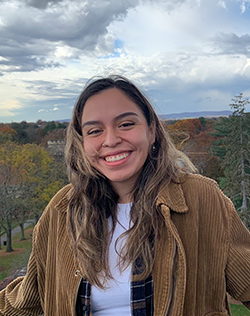 Gabrielle James
Gabrielle JamesUS EPA GreenChill
Washington, D.C. (Virtual)
Yá’át’ééh! My name is Gabrielle James and I am a member of the Navajo Nation. Right before I started my Institute for Tribal Environmental Professionals (ITEP) internship, I graduated from Vassar College with my B.A. in anthropology and a minor in urban studies.
I spent eight weeks working with the U.S. Environmental Protection Agency Stratospheric Protection Division. I worked closely with my supervisor in the GreenChill program, which is a voluntary EPA partnership program that works with the food retail industry to reduce refrigerant emissions and decrease their impact on the ozone layer and climate change. Throughout my internship I was able to meet with staff members in the SPD, network within the EPA, and develop and work on projects collaboratively with my supervisors and SPD staff. The main project that I worked on during my internship was building a foundation for the GreenChill program to connect with grocery retailers on federally recognized tribal land. This included meeting with current GreenChill partners and stakeholders, outreach to grocery retailers on tribal land, and individual research about food sovereignty and grocery retail on tribal land. Through this project I was able to not only expand my own knowledge on grocery retail on tribal land and refrigerant emissions, but develop my networking and communication skills by meeting with EPA staff and GreenChill partners.
Prior to this internship, I knew little to nothing about refrigerant emissions but after eight weeks I was able to have an understanding of best environmental practices concerning refrigerant emissions and more environmentally friendly technologies. There definitely was a learning curve at the beginning of this internship, but with the help from my supportive supervisors and SPD staff I was able to ask questions and learn in a welcoming and encouraging environment.
I started this internship with wanting to learn more about working for the federal government and expanding my knowledge of environmentalism and sustainability at the federal level. This internship gave me an amazing opportunity to experience policy development and government functions. If you are looking at ITEP internships, I would definitely recommend applying because you will learn so much and gain experiences that you didn’t expect. This program has inspired me to continue pursuing a career working at the federal level and working with indigenous communities.
Kaya Tate
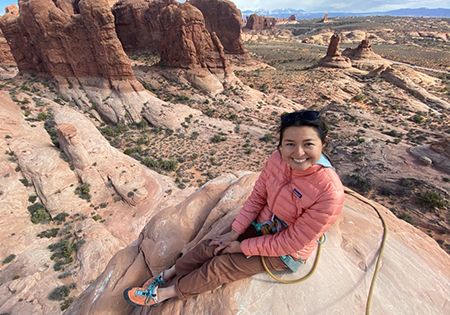 Kaya Tate
Kaya TateNorthwest Indian College
Belllingham, WA (On-Site)
My time interning at Northwest Indian College under John Rombold’s supervision was divided into lab, field, and extracurricular activities. A considerable amount of time was devoted to fieldwork, 1 – 2 times a week. Fieldwork activities included boat sampling, soil sampling, and assisting the Lummi Natural Resources Department in their invasive species reduction efforts. Soil sampling consisted of gathering 10 bags of soil from diverse locations on the Lummi reservation and in Bellingham, targeting biologically rich areas. The first set of samples were gathered from Birch Bay State Park, where I shoveled samples of dirt into bags, noting the precise coordinates and taking pictures of the site. This activity was completed 3 times throughout the internship, contributing to the primary lab project.
The primary lab project I worked on is called Science Education Alliance-Phage Hunters Advancing Genomics and Evolutionary Science (SEAPHAGES). Designed to be a process covering 2 semesters, it is an experiential research course that uses various microbiology techniques and aims to progress into genome annotation. The program studies bacteriophages The purpose of the program for me was to solidify my confidence in performing in a lab environment and to stimulate an interest in genomics and microbiology. This program is comprised of a “wet bench laboratory”, indicating a type of lab environment requiring the use of wet hazards and chemicals, so it needs to be meticulously designed and controlled to avoid contamination. This lab also introduced me to the field known as “bioinformatics”, an interdisciplinary study that develops methods for interpreting biological data. It can use the fields of biology, chemistry, physics, computer science, etc.
Lauren Adeline Estrella
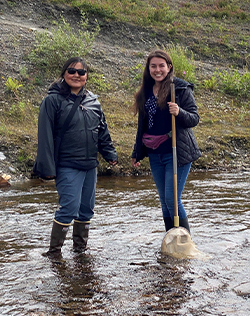 Lauren Adeline Estrella
Lauren Adeline EstrellaAlaska Community Action on Toxics (ACAT)
Anchorage, AK (Hybrid)
I spent this summer working mostly remotely for Alaska Community Action on Toxics (ACAT), a statewide environmental health and justice organization that empowers communities to eliminate exposure to toxics through collaborative research, shared science, education, organizing, and advocacy, all while supporting the rights of Indigenous peoples. The main focus of my work was to create a statewide map illustrating the different facilities in Alaska that release toxic air pollutants. The last two and a half weeks were spent in both Anchorage, AK and Nome, AK, where I helped ACAT with their Field Institute. This was a class taught to leaders from various communities about environmental justice, how toxins are affecting Alaskans, and how to be proactive with the use of various air and water monitoring devices.
Overall, this internship experience has been life changing. It has prompted me to ask more questions, engage with others, and share the knowledge I have learned. My time with ACAT has helped in me learn, grow, and has inspired me to teach my community and fellow Natives new ways to make a positive impact on the environment in ways that are relevant to them. I am beyond grateful for this experience and want to give a heartfelt thank you to Northern Arizona University’s Institute for Tribal Environmental Professionals SSI program for making this all possible. This will be yet another summer I never forget.
Nizhoni Tallas
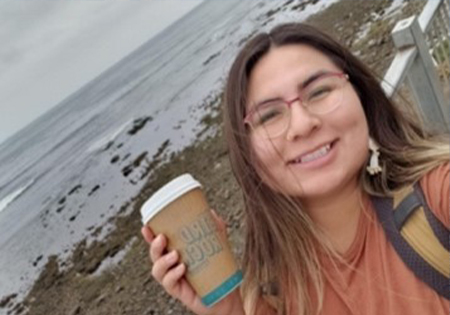 Nizhoni Tallas
Nizhoni TallasClimate Science Alliance
San Diego, CA (On-Site)
I highly recommend applying for an ITEP internship. When I was searching for internship opportunities, I came across this program and applied right away because they primarily focus on tribal communities and environmental topics. I thought the structure of applying was great too because you get to look at all the available host sites and choose which sites you would like to send your application to. Being able to have a choice in choosing from all the various tribal organizations was nice and a great way to learn more about other sites outside of your state that are also doing great work with tribal communities.
Even though it could be challenging to take that next step in your educational journey, ITEP makes it possible for you to have the support to take that step. Being able to travel and live in another state is an amazing experience and you learn a lot about yourself and at the same time work at a site that works with tribal communities. My experience living in San Diego for the summer was awesome. I met and learned from several tribes in the region which was so cool and fun. It also helped me see the impact that an organization like Climate Science Alliance can have on a tribal community when there is trust and meaningful relationships built. Also, experiencing firsthand what reciprocity looks like between an organization and tribal communities was beneficial and insightful since I will continue to work with my tribe and other tribes throughout my career.
During the summer I had plenty of time to join outreach activities, meetings, and projects that helped refine my skills in team building, writing, public speaking, and having confidence in myself. The team at Climate Science Alliance was incredibly supportive and gave me the freedom to work on projects that revolved around my interests. I’m sure the other internship sites part of ITEP are the same way. I say take that chance and experience something different and enhance the way you see the world and what you hope to become in the future.
Teresa Topete
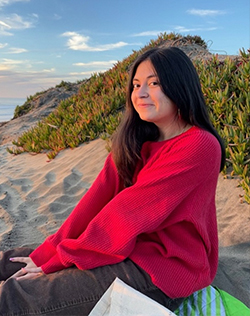 Teresa Topete
Teresa TopeteNational Tribal Air Association
Flagstaff, AZ (Remote / Virtual)
For 8 weeks I interned with the National Tribal Air Association where I did research, designed cover pages, and got a glimpse of working with air quality policy. In my day to day tasks, I found articles and resources for our weekly newsletter and eventually learned how to use the website editing software to upload the newsletter onto the NTAA website. Outside of the newsletter and website design, I also got to do research on the various air quality policies NTAA provides Tribal organizations with resources for. EPA’s Clean School Bus Program is just one of many programs I researched and created resources for. NTAA’s commitment to helping Tribal organizations voice their public health needs and keep their communities protected has been extremely inspiring to me, and I am so grateful to have contributed to this crucial work that is being done. Additionally, I worked on a public comment letter regarding the Supplemental Environmental Projects or (SEPs) that was sent to the Department of Justice. Being a small part of this action to build a cleaner future has been so special and motivates me to continue in the field of environmental justice, as I pursue a career in environmental law and sustainability. I am so thankful for my experience as an ITEP intern, and encourage anyone interested in careers in the environmental field to consider this unique opportunity.
Valerie Doornbos
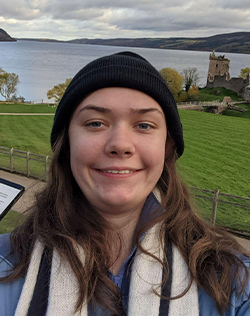 Valerie Doornbos
Valerie DoornbosWhiteswan Environmental (WE)
Seattle, WA (Virtual)
One of the main reasons why I selected Whiteswan Environmental (WE) as a host site was because I was intrigued, passionate about, and inspired by their commitment to 7th Generation Sustainability, cultural safety, and healing at all levels. My time as an intern only increased my passion for working on these topics. Shirley was an excellent mentor and I always felt supported and encouraged by her. My fellow WE interns were fantastic and amazing people!
I was fortunate enough to conduct a wide variety of projects and activities during my 8-week internship. Myself and my fellow interns successfully organized and hosted two community outreach and four speaker series events. The speaker series events topics were: Air Quality, An Introduction to the Northern Arizona University (NAU) Institute for Tribal Environmental Professionals (ITEP) Internship Program, Indigenous Knowledge and Air Quality, and finally, Community Programs and Air Quality. We also organized and collected 442 responses on our air quality survey, reaching people as far away as the United Kingdom and British Columbia. We created traditional language TikToks on the AirNow FLAG program using the tribal resource guide they provided. We also created a resource brochure based on questions people had asked in the survey, and emailed it out to respondents (a few paper copies will be distributed as well).
This internship has influenced my future choices for careers by solidifying my passion of collaborating with Native communities on environmental issues. Although I identify as non-Native, I truly believe it is important for everyone to work together because we all hold a puzzle piece of knowledge. If some voices are left out, we truly do not have a complete understanding of an issue, and therefore it becomes impossible to solve and often facilitates cultures of harm. If you are interested in the environment or collaborating with Tribal nations, you should definitely strongly consider applying for this internship. THANK YOU Shirley and my fellow WE interns for making this such a wonderful and informative eight weeks! Everyone should consider being a WE intern!
2022 Water Resources and Land Management Summer Intern
Brandee Joe
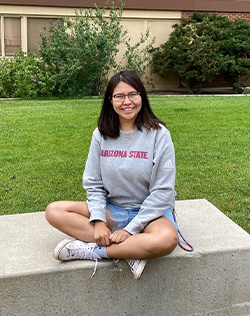 Brandee Joe
Brandee JoeCenter for Adaptable Landscapes / School of Earth and Sustainability
Northern Arizona University, Flagstaff, AZ (Hybrid)
This past summer, I had the opportunity to receive an ITEP internship. It was a great learning experience overall. A lot of the work I did was hands-on and that allowed me to better understand what I am capable of doing. It also made me become more interested in what I was learning. The individuals I worked with were very considerate and helpful. Not only did they help to increase my interest in the work we were doing, they also helped me in any way they could when I struggled.
Brooke Damon
 Brooke Damon
Brooke DamonUSGS, Grand Canyon Monitoring and Research Center
Flagstaff, AZ (Hybrid)
Yá’át’ééh, shí éí Brooke Damon yinishyé. Ta’neeszahnii nishłį, Tsin sikaadnii báshishchíín, Tábaahá dashícheii, dóó ‘Ashįįhíí dashínálí. Hello my name is Brooke Damon, I am of the Tangle People clan, born for the Clamp Tree clan, my maternal grandfather is of the Water Edge’s clan and paternal grandfather is of the Salt People clan.
I am currently a third year student at Northern Arizona University majoring in Environmental Sciences with an emphasis in Biology and minoring in Chemistry. During my ITEP internship I was able to work with USGS and create an annotated bibliography that contains tribal interest and concerns over time in the Glen Canyon Dam Adaptive Management Program. Although this doesn’t seem very interesting or groundbreaking since the majority of it I spend reading and writing. Throughout the internship I was able to work closely with the scientists and researchers from USGS, join in on the GCDAMP work group meetings, and gain some field work experience. This experience is one I could not be more grateful for as it pushed me out of the box I put myself in and allowed me to grow. I could not have asked for a better summer.
Chelsie Fowler
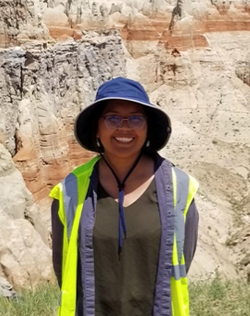 Chelsie Fowler
Chelsie FowlerNAMLRD (Navajo Abandoned Mine Lands Reclamation Department)
Shiprock, NM (On-Site)
The ITEP internship that NAU was able to provide was an amazing experience for me because I was able to immerse myself in a new environment and learn new skills that will prove to be beneficial in the future for my chosen career: Environmental Engineering. Taking that step forward in trying something new has really paid off and is an experience that I will never forget. I am thankful to ITEP and the host site staff for allowing me to grow within a short time frame. I was able to pick up technical skills and learn more about the engineering project development process, which relates to my chosen career path.
The internship that I had the opportunity to work with gave me the chance to go out into the field, learn how to use new technology, and do administrative work. It has given me an insight to how work life is and what it means to be part of a company that helps out the Navajo community. Having an internship through ITEP has been very educational and cost effective because I was able to get paid for working, along with housing taken care of. Without this internship, I would not have been able to work with professionals, go out of my comfort zone, and gain new experiences that I can put on my resume. I am grateful for the opportunity I had this summer and the amount of time that everyone from the ITEP and host site were able to set aside to help improve myself.
The internship that I had was life changing and has encouraged me to continue on with my education so that I can give back to my community on the Navajo Nation.
Christine Longjohn
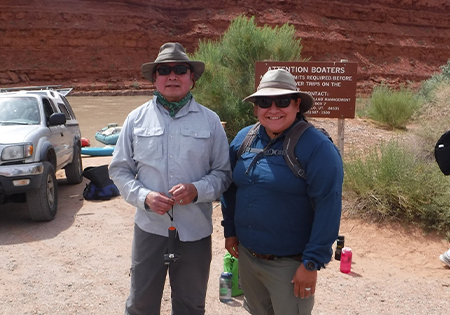 Christine Longjohn
Christine LongjohnThe Nature Conservancy
Durango, CO (Hybrid)
Working with ITEP and NAU, I was able to get a position with The Nature Conservancy. A non-profit that can be very competitive to get an internship with. I wanted this to be my next experience for summer work, since returning to school. This internship opportunity has been an amazing experience. I was able to work with the TNC with multiple tribes in the area of the San Juan watershed as well as federal/state and other non-profit organizations that are working on managing the San Juan River. I was ready to strengthen my skills for my professional career. Needing a complex network to see the ins and outs of the collaboration work that would be across multi-district and management landscape.
The ITEP internship allowed me to work and use critical thinking to develop my proposals for future work on tribal lands. I was given a very broad need and had to narrow down information from my previous research and work I had been doing during my master's program to integrate that into a proposal for TNC. My work with restoring floodplain connectivity is complex in the broader Colorado River Basin where returning the flows needed is looking harder to get with the increasing challenges of climate change and consumptive use. This gave me great organizational, critical thinking, development, communication, and outreach skills. Because of this opportunity, I was able to attend a wonderful in-the-field work development collaboration river trip, with tribal entities. This enhanced my mentors and peers for future opportunities in building a bridge. All of this helped me be prepared for my next job as a biologist helping tribal nations across the U.S.
These internships are hands-on experiences in some of the most competitive positions. They give you real-life professional experiences while creating the best opportunity to broaden your network. You will get the best chance to interact with other tribal leaders to build that connection and help further your careers.
Fred Toins III
 Fred Toins III
Fred Toins IIINavajo Nation Department of Water Resources - Water Management Branch
Fort Defiance, AZ (On-Site)
I was an ITEP intern in the summer of 2022 at the Navajo Nation Department of Water Resources- Water Management Branch in Fort Defiance, Arizona. In this internship, I was involved in a few projects that assisted Navajo nation communities with water, electricity, and crop production associated with irrigation, wells, lakes, and reservoirs. This internship gave the opportunity for Fred to help take on the responsibility to manage the Navajo Nation water resources for the benefit of present and future generations to sustain long term socio-economic development while protecting the nation’s sovereignty over its water.
Following the completion of my internship, I will say that this was overall the best decision I could ever make following graduation. It has prepared me and gave me experience of what to expect when working in this specific field of study. Not only have I gained experience, but it looks great on your resume especially if you don’t have any experience at all following graduation. After all, just having a college degree will not always secure you of a job, especially in 2022. Not saying an internship will secure you a job, but it will most certainly enhance your chances of being selected by an employer. As a result, you consider an ITEP internship that will give you not only a learning experience, but a better chance at success!
Joshua Mike
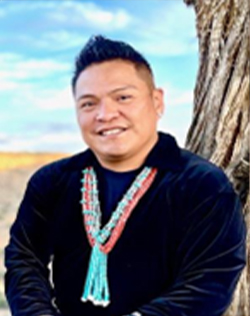 Joshua Mike
Joshua MikeNASA Ames Research Center
Moffett Field, CA (Remote)
Yá’át’ééh (hello). My name is Joshua Mike. I am from Farmington, NM and am a member of the Great Navajo Nation. I am currently a senior at Fort Lewis College in Durango, CO and am studying Environmental Conservation Management. I am excited to share with you all why ITEP has been an important internship opportunity. I would like to first introduce to you ITEP’s mission: " ITEP strengthens tribal capacity and sovereignty in environmental and natural resource management through culturally relevant education, research, partnerships and policy-based services. " I have witnessed firsthand the manifestation of this mission statement with my summer internship placement. I was excited to participate as an active team member with the Bay Area Environmental Research Institute/NASA Ames Research Center. It is my strongest belief that when I was given the opportunity to work with NASA, ITEP envisioned that this NASA host site would nurture their interns in alignment with ITEP’s mission.
At NASA, I was welcomed in by a team known as the Indigenous Peoples Capacity Building Initiative (IPCBI). This team is cutting edge and is excelling with the work they do with tribal nations throughout the United States. IPCBI has been actively seeking opportunities to create workshop training sessions for tribal nations with an emphasis on using Earth Observations (EO) as a tool to provide data and knowledge. The IPCBI works with indigenous communities to promote ethical and culturally relevant space for the use of EO in monitoring, mapping, and managing natural and cultural resources. The foundations of the work that IPCBI does include co-developed workshops to ensure that challenges that indigenous people face can be helped with EO at the same time ensuring that equity and environmental justice is maintained for those indigenous communities. Both ITEP and NASA have provided me the challenge of researching, critical thinking, and fulfillment in my work as well as skillsets that I can employ in both academics as well as whatever career I choose soon.
Karis Black
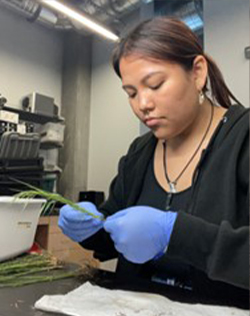 Karis Black
Karis BlackChemistry Department, Northern Arizona University
Flagstaff, AZ (On-Site)
In the 10 weeks I worked in Dr. Jani Ingram’s lab I was exposed to research, field, and lab work. I worked with a variety of graduate and undergraduate students who are very intelligent, inspirational, and inclusive. Although I was one of the youngest, each member of the lab gave me advice about my career decisions along with resources that helped throughout their undergrad experience. I learned how to work with various lab equipment such as a microwave digestor and an Inductively-Coupled Plasma Mass Spectrometer(ICPMS). The procedures for each were confusing at first but towards the end of my internship duration, I understood how each system operated and had the ability to teach someone how to operate each.
I had the opportunity to travel to Yuma/Somerton, Arizona to observe Cocopah’s environmental protection officer do field sampling. Due to our Quality Assurance Plan(QAP) not being approved when Cocopah was doing their quarter sampling, we did not have the qualifications to take any samples back to the lab. Overall, the trip was fun, I had the opportunity to learn about another culture, try local restaurants, and went swimming. This trip was to scope out the sampling sites Cocopah utilizes so we can do our own sampling trip in the near future.
ITEP’s internship is a great learning opportunity that allowed me to explore my passions and have a better sense of what I want to do in my future career. I experienced what working in a lab is like and felt a sense of community while learning something new every day. I would recommend this internship to anyone who is the slightest bit interested in fieldwork and working in a lab!
Moya Moses
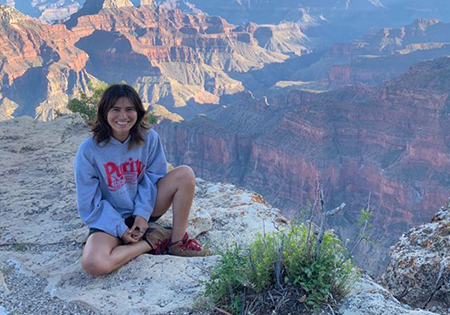 Moya Moses
Moya MosesBiology Department, Northern Arizona University
Flagstaff, AZ (On-Site)
Hello, my name is Moya Moses, I am a rising junior pursuing an undergraduate degree in urban and regional studies at Cornell University. This summer I interned at Northern Arizona University in Flagstaff Arizona. ITEP made the whole process incredibly easy and efficient from the application process all the way to arranging my flight back home. While I was out here I had the incredible opportunity to work with a group of NAU graduate students on a multitude of projects. Most of my work consisted of vegetation surveys, pollinator observations, and data entry. I was out in the field for almost the entirety of my stay, which meant a lot of sun and a lot of fun.
Some work highlights were doing almost 100 hours of vegetation surveys, learning a bunch of data collection protocols, and getting over my fear of bees and coming to find them cute! I also gained a great look into the lives of a range of environmentalists. I had a wonderful and truly enriching experience getting to know more about the field. I would strongly recommend an ITEP internship to anyone looking for a look into the world of environmental professionalism and hands-on skill building.
Myra Badonie
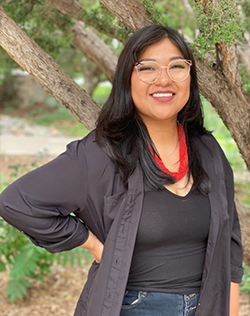 Myra Badonie
Myra BadonieBiological Sciences Department, Northern Arizona University
Flagstaff, AZ (On-Site)
Yá’á át’ééh (Hello), I was given the opportunity to work as an intern for the Institute for Tribal Environmental Professionals (ITEP) for the summer of 2022. My project host site was based in Flagstaff, AZ at Northern Arizona University Biological Science Department, studying two invasive species in the Lake Powell reservoir that provides water for 38 million people (about twice the population of New York) in the Southwest including 22 tribal nations alone in just Arizona. Navajo Nation has extensive water rights in both the Upper & Lower basins of the Colorado River watershed, but over 40 percent of Navajo residents still lack access to running water. With the recent Navajo Generating Station closure in Page, AZ, Navajo Nation has proposed the water intakes lines be repurposed and to provide western agency residents with running water. The aim of the study was to conduct preliminary surveys around the southern and northern regions of the Glen Canyon Nation Park area, where population size was quantified and observe if there were habitat preference to different geological sediments where freshwater bivalve's colonies are located. We conducted a series of samples based on population abundance or absence within a shoreline adjacent to where colonies once thrived.
This research gave me the opportunity to work independently and build relationships among the faculty in a research setting. This allowed me to improve upon my skill sets in data collection and experimental lab setups with living colonies. If you are to consider this opportunity, this experience will shape your ability to do scientific research in the lab and field site setting, along with learning multiple subjects of science that cannot be covered in a classroom setting. As I step into the next part of my academic journey, I am overjoyed with the new avenue of opportunities this internship has made available for me to take, and the amount of support from faculty and coworkers, helps me feel ensured I am on the right path.
(Marissa) René Castillo
 (Marissa) René Castillo
(Marissa) René CastilloNavajo Nation Department of Water Resources - Water Management Branch
Fort Defiance, AZ (Remote)
Being an ITEP intern is a unique experience that overall, better prepared me as a scientist and student. Before ITEP, I didn’t have any real-world application experience of the science that I major in. This summer I worked virtually as an intern with the Navajo Nation Water Management Branch. I got hands on experience using remote sensing, hydrology, and GIS analysis together to help people and do cool science. I used this internship to grow and build a network of not only of my peers but of scientists in fields related to my interests.
What I learned from the experience was more than just science. This program developed me professionally in other ways, helping build presentation confidence, build coding and cartography skills through Google Earth Engine and ESRI GIS mapping, and leadership by teaching and working with another intern from a different science application field.
There are many virtual internships you can do, but if you have the flexibility and want to learn more about water management, I suggest the Navajo Nation Water Management Branch. You can build skills useful not just for the return to the classroom next semester but also for the work force all while serving others through knowledge and science. It’s a unique opportunity to work with mentors who care not just about the project you complete, but the development of you as a professional and as a scientist.
Shanya Whitehorse
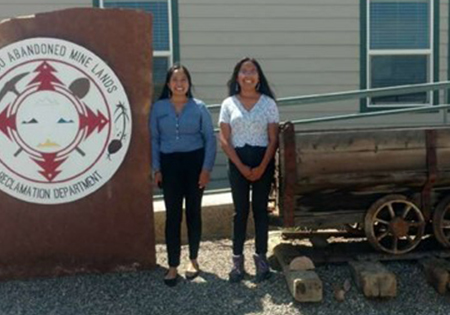 Shanya Whitehorse
Shanya WhitehorseNAMLRD (Navajo Abandoned Mine Lands Reclamation Department)
Shiprock, NM (On-Site)
With the help of ITEP, I was able to get an internship with Navajo AML in Shiprock, NM that has opened multiple opportunities. I came to Navajo AML with no knowledge of abandon mines, but I would casually see coal piles in front of local housing without a fence and a sign addressing its environmental and health hazards. It wasn’t until my internship that I realized this is a serious problem on the reservation and most Navajo people don’t know that. Without Navajo AML and its mentorship being able to teach me the history and the process of reclamation, I wouldn’t have known anything like this existed. I am thankful and excited to have completed this internship and encourage other students to pursue opportunities like this so they can have options after they graduate.
Tracey Begaye
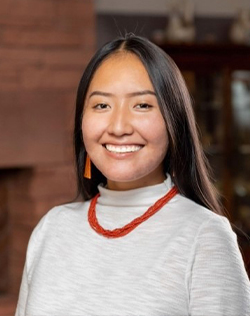 Tracey Begaye
Tracey BegayeNavajo Nation Water Management Branch
Fort Defiance, AZ (Hybrid)
I am an ITEP intern for the Summer of 2022 with the Navajo Nation Water Management Department based in Fort Defiance, Arizona. I researched a cloud-based web application - the Drought Severity Evaluation Tool (DSET) - to improve drought reporting and management in the Navajo Nation. I am reflecting on all the work I have performed during this internship program as I finish up my final week, and I am happy to have contributed.
Because I gained more expertise in remote sensing and hydrology, future interns should think about participating in the ITEP program. Additionally, my professional abilities have improved, which has prompted me to think about keeping my interest in remote sensing. I am relieved that I was able to use my coding knowledge and maximize my application of the available resources. For my summer project, I had the good fortune to collaborate with my supervisor Carlee McClellan and partner Rene Castillo. They both gave me in-depth hydrology knowledge and helped me work as efficiently as I could.
2021 Summer Interns
Lauren Adeline Estrella
 Lauren Adeline Estrella
Lauren Adeline EstrellaAlaska Community Action on Toxics (ACAT)
Anchorage, Alaska (Virtual)
I believe the Creator intended for us to live harmoniously with the earth, not to pollute it with waste. I am a single mother and did not want my daughter to grow up having to accept “it is what it is”, which was one of the reasons why I had applied to the Environmental and Occupational Health master’s program at CSUN. I intend to use my background in biochemistry, skills in analysis of scientific research, and newfound knowledge to prove that our actions can influence the world for the better.
The ITEP internship made this goal a possibility. I spent 8 weeks working remotely for Alaska Community Action on Toxics (ACAT), a statewide environmental health and justice organization that empowers communities to eliminate exposure to toxics through collaborative research, share science, education, organizing, and advocacy, all while supporting the rights of Indigenous peoples. Over the summer, I was able to put my skills to work by conducting an immense update of the North Slope Report, which displays the top ten air pollutants in the North Slope Borough of Alaska. The health effects of exposure to these pollutants were researched and included in the report, and trends in air emissions were shown, along with comparisons to other states. This report is to be shared with tribal leaders and distributed amongst the Nuiqsut community, giving them solid evidence to help voice their concerns. I was also able to promote newly established programs by creating social media engagements for both Facebook and Instagram. Additionally, I created multiple factsheet and infographics on topics such as climate change in the Arctic, climate change and children’s health, air pollution sources and the economic benefit of mitigation, air pollution and breast cancer, and the limitations in the process of incinerating PFAS-contaminated soils. The support I received throughout the internship was phenomenal and is a prominent attribute of my time here with ACAT. Even though we were all working from different locations, it really felt like we were a family working together, which was extraordinary and refreshing. This support had me excited about my assignments, as it helped me strive to put in more effort and produce better work.
Overall, this internship experience has been life changing. It has prompted me to ask more questions, engage with others, and share the knowledge I have learned. My time with ACAT has helped in my learning and growth, and has inspired me to teach my community and fellow Natives how they can make a positive impact on the environment in ways that are relevant to them, starting with an Indigenous Wellness Cohort. I am beyond grateful for this experience and want to give a heartfelt thank you to Northern Arizona University’s Institute for Tribal Environmental Professionals Summer Internship program for making this all possible, even during a pandemic. This will be a summer I never forget.
Rhonda Papp
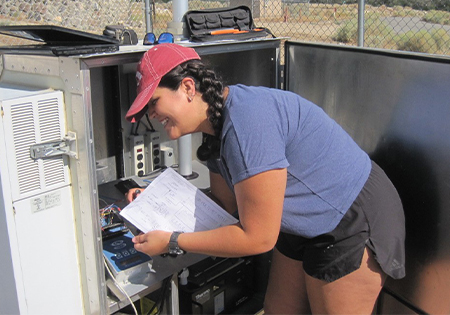 Rhonda Papp
Rhonda PappBig Pine Paiute Tribe of the Owens Valley
Big Pine, California (Virtual)
My time in my ITEP summer internship with the Big Pine Paiute Tribe (BPPT) of the Owens Valley is one that is concluding my final chapter of personal growth within the last year. It is currently July 30th, 2021, and I am really reflective of the last year and some months of being in COVID-19’s grip of quarantine and how it has shaped me. In essence, I am truly grateful to have such a supportive team in the BPPT Environmental Department, ITEP, and through all the individuals I met and learned from this summer.
I worked directly with the Tribal Air Program Coordinator, Environmental Director, and Water Program Coordinator on coordinating, planning, and researching three main tasks. The first being researching and planning a poster making workshop for Big Pine youth on air quality and wildfire events. The next being researching and developing a green building article for community members to implement some “green building techniques” in their own home. Finally, I worked on developing and planning the BPPT Environment Department’s social media. My time has been spent doing meaningful and valuable work for the Big Pine Paiute Tribe of the Owens Valley. It offered a unique and necessary experience to work for a tribe and people who are resilient, powerful, and refreshing from my little world in San Diego. There is so much that we can learn from working in the field that we are interested in. My last eight weeks taught me that the only thing that is certain is uncertainty, and we should never force our expectations to match our reality. In all, I highly recommend that anyone interested in pursuing a career in environmental science pursue an internship with ITEP.
Ayden Clytus
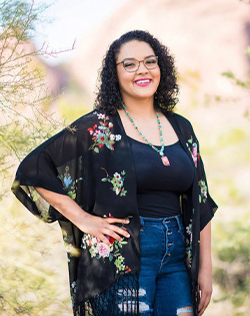 Ayden Clytus
Ayden ClytusEPA Climate Science and Impacts Branch
Washington DC (Virtual)
The saying that “time fly’s by when you’re having fun” could not have been more applicable to my summer experience. Within a span of 8 weeks, I had lots of fun and I grew so much as a person. I got to learn about numerous opportunities and concepts this summer that I had no idea were possibilities. When I first saw the ITEP summer intern program I did not think it was for me, a Justice Studies major whose world revolved around policy, law, and justice for others. However, my world also focused on the health of the Earth and our communities. I was stuck trying to understand how to combine the two. I have always had a respect for the land, what it gives to us, and what it teaches us. This comes from traditional values taught to me by my mother and grandmother. These values keep me grounded and have guided my path through education and my search for a future career. So, with encouragement from both parents, I decided to just apply for the summer internship and see where that went.
In the end I applied to four host sites, got two interviews, and one acceptance from EPA’s Climate Science and Impacts Branch. I was so excited but intimidated at the same time. I had this perception that EPA was full of scientists who just took samples and analyzed them, which some do, but this was not what the people I worked with did on a daily. I was also worried that since it was a federal government agency that they would be very strict and slightly unapproachable, and I wanted to make sure I impressed somehow. This was the complete opposite of the people I worked with. They were friendly, understanding, everything you would hope for in a colleague and I was beyond grateful for that. Rather than take samples and create reports, I read those journals and reports to understand climate change and how it would affect health, economy, and infrastructure for example. I was given three tasks; 1) build a CASTNET tribal program partners page for the EPA website, 2) Research climate change’s effects on the Arctic, which included the impacts on the health of Alaskans, Indigenous peoples, and economic impacts, and 3) write a paper on climate change nationally, its impact on water, and how that will ultimately impact children’s health and Indigenous people within the United States. In addition to my three projects, my three project leads introduced me to many different people who worked in areas I was interested in. Those areas of interest were water, law, how tribes and the federal government work together, and environmental justice. I met with people who handle climate policy, an environmental justice attorney, a woman who works on safe drinking water in EPA and has an interest in environmental justice work, and much more. Each of these individuals offered me different knowledge and advice for future work or paths I could take. Each of the meetings I had were enlightening in some way. I learned so much from the projects I worked on and the people I met whilst at EPA.
All in all, I would highly recommend considering an ITEP summer internship. Even if you feel like maybe you will not fit in with the host sites, like me, you would be surprised just how much you do fit in. This internship taught me so much and I met great people. You might just find the career that works for you. For a long time, I was trying to figure out how I could make a Justice Studies degree work in favor of my passion for a better environment and working with EPA showed me where my place could be. It reassured me that I was on the right path, and I have grown tremendously in only two months. So, if you are even considering applying for an ITEP internship, I say go for it, you never know where you will end up.
Chantel Jones
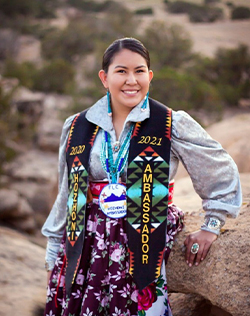 Chantel Jones
Chantel JonesEPA Region 3 – Air and Radiation Division
Philadelphia, Pennsylvania (Virtual)
The Institute for Tribal Professionals has not only provided me with an excellent educational experience, but an opportunity to rethink my career path. While completing my internship, I was exposed to a positive learning environment in which I was encouraged to complete hands-on work that would be used heavily by my mentors. I was able to build many professional relationships with several tribal and environmental professionals, who not only valued my work and effort, but viewed me as an important and pushed me to learn more about what I am capable of. Much of my work included how to communicate with tribes, assess environmental needs, learn about health outcomes relating to poor environmental conditions, and how such issues can be resolved to improve the quality of life for all.
The ITEP internship is an excellent opportunity for all future environmental leaders to build their career and professional skills, while gaining real-world working experience to learn more about what their capable of accomplishing. To be surrounded by kind and empowering leaders is a one-of-a-kind experience that not many are able to come across. Since completing my time with ITEP, I have not experienced a career path change but have used each of my learned experiences in more ways than one. With much gratitude to the Institute for Tribal Professionals, I now hold the knowledge to help my community.
Valerie Doornbos
 Valerie Doornbos
Valerie DoornbosUS EPA Region 9 Indoor Environments Team
San Francisco, California (Virtual)
This internship was a wonderful experience! As an ITEP (Institute for Tribal Environmental Professionals) Intern, I worked with various tribes around Region 9 who have a IAQ (Indoor Air Quality) commitment in their GAP (General Assistance Program) workplan. I contacted them by phone or Zoom and offered to provide technical assistance, answer questions, and share additional resources. My supervisors at Region 9 provided me with a list of tribes who had these commitments in their FY 21 and 22 workplans. I then had my supervisors send out an introductory email, and then I followed up with an email where I introduced myself, described my project, and asked if I could ask them a few questions including how their IAQ work was going, the results of past projects, if they were aware of the FLAG program, and if I could provide technical assistance, among others. I then took notes during these meetings, and organized the data into a spreadsheet, where I was able to summarize it. There are currently a total of 36 tribes in Region 9 with IAQ commitments (25 in CA, 6 in AZ, and 5 in NV), and I was fortunate enough to speak with 24 of them, which is a roughly 67% response rate. I am so thankful that tribes were willing to speak with me, as it was their participation which made this project a success. I had access to numerous opportunities including trainings, webinars, networking, and agency meetings.
This internship solidified my interest in working in the environmental field, and I learned so much. I had the opportunity to complete hands-on work with tribes in Region 9, and I even presented my findings at the Regional Tribal Operations Committee (ROTC) meeting, and RIPSC (Regional Indian Programs Steering Committee) talk. I also briefed a senior manager and gave a brownbag presentation. I am certain that I will be able to use the information I gained here in graduate school and my future career. If you are interested in working for the federal government, or have a passion for collaborating with tribes, I highly suggest you look into an ITEP internship!
Amanda Freele
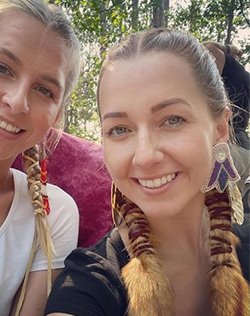 Amanda Freele
Amanda FreeleUSEPA Stratospheric Protection Division
Washington DC (Virtual)
Bozhoo (Hello)! My name is Amanda Freele, I am a member of the Sault Ste Marie Tribe of Chippewa Indians. I recently graduated from Michigan Technological University with my B.S. in environmental engineering and will be going back for my master’s degree.
This summer, I got the opportunity to intern through the ITEP program again. My host site was with EPA’s Stratospheric Protection Division (SPD) in which I worked with EPA’s GreenChill and Responsible Appliance Disposal (RAD) programs. Environmental justice/equity is gaining momentum within the EPA, which I was happy to be a part of. I was tasked with creating outreach material as well as engage with Tribal communities to talk about the RAD and GreenChill programs. Finding out what would benefit our Tribal communities and what they want to see, and then responding on those topics is how I found the best way to tailor my outreach materials. During my eight-week internship I completed some milestone projects like creating an outreach document for Tribes, holding a webinar for Tribal municipalities, utilities, and interested community members to learn about the RAD program, and creating a fact sheet with the target audience being Tribal communities for the GreenChill program. These are the ways I helped the respective programs work toward their equity goals. Because SPD is within the Office of Air and Radiation, I was able to learn a lot about what the EPA does in terms of regulating air quality concerns and what they are doing to implement new regulations.
During my experience I learned a lot about refrigerants and hydrofluorocarbons (HFCs). There are different kinds of refrigerants that may be better or worse for causing greenhouse gasses, as well as refrigerated appliance foams that may contain ozone depleting substances; both greenhouse gasses and ozone depleting substances lead to climate change. The EPA has voluntary programs for these issues, which allows their partners to go above and beyond regulatory standards to help combat against climate change. I had an amazing experience working for the Federal government. Not only did I work with a great team, I learned a lot from everyone and from weekly EPA learning sessions from outside of my division. I got an inside look at how the government functions and interplays with industry and communities. This experience is one that has truly broadened my knowledge on air quality and my interests in where I may work for my future career. I highly recommend the ITEP Internship Program to any Anishinaabe looking for a bright future in air quality, as this program has inspired me to focus my higher education in this field. Miigwech (Thank you)!
Jonathan Credo
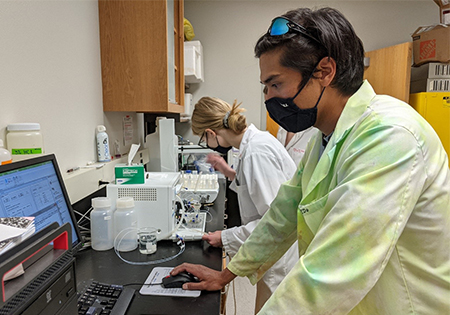 Jonathan Credo
Jonathan CredoNorthern Arizona University/Cocopah Tribe
Flagstaff, AZ / Yuma, AZ
The ITEP internship is an excellent opportunity to provide interns of any level with introductory and intermediate experience with working with tribes and air quality. In my internship, I was given a significant amount of freedom that allowed me to learn what goes into being a successful scientist, including how to establish collaborations with tribal entities. I learned a lot about the environmental justice and environmental health issues that face the tribe that I worked with. I have worked with tribal and minority communities since 2010, and it is always a wonderful and humbling experience when establishing a new partnership. Environmental justice and environmental health issues are ever present, and it requires passionate individuals that are willing to work with in these communities if we are to change the world for the better. Interns should be aware that not all internships follow a rote set of directions and should be prepared to exercise a level of independence. All in all, I can only speak of good things from the paid internship.
Gabrielle James
 Gabrielle James
Gabrielle JamesNorth Central Climate Adaptation Science Center
Boulder, CO (Virtual)
My name is Gabrielle James and I was an ITEP intern in summer 2021 with the North Central Climate Adaptation Science Center based in Boulder, Colorado. I spent eight weeks building a directory of climate adaptation plans and other environmental related materials from resources created by thirty-two federally recognized tribes in the Northern Great Plains region. In addition to that work, I did research on a couple of specific projects that tribes were working on such as beaver mimicry and research on how climate change impacts Native American health. I was able to strengthen my research and writing skills throughout the eight weeks I was an ITEP intern while working closely with my supervisor who is a professional in the field. While I was doing research, I was also able to meet and have conversations with other people who work in the field. Prior to this internship, I knew very little about climate adaptation planning efforts and the challenges that are presented in Tribal climate adaptation work.
Following the completion of the internship, I am entering my final year of my undergraduate education and I am strongly considering looking for and applying to jobs that are in related fields. As a Diné student about to graduate, this research experience was invaluable as I’m also about to write my senior thesis and final projects based on what I’ve learned through this internship. Future interns should consider an ITEP internship because my knowledge of Tribal climate adaptation work has increased more than I thought it would at the start of my internship, and I have a desire to pursue a career in a related field.
Victoria Konen
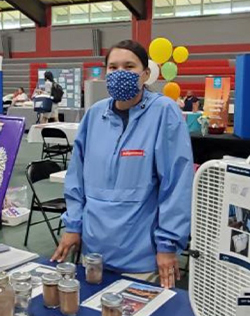 Victoria Konen
Victoria KonenNez Perce Tribe ERWM Air Quality Program
Lapwai, ID
Hello, I am Victoria Konen, an enrolled Nez Perce Tribal member. This summer I worked with the Nez Perce Tribe Environmental Restoration Waste Management (ERWM) Air Quality Program under the Institute for Tribal Environmental Professionals (ITEP). I assisted the Program to increase awareness through culturally relevant air quality, science outreach, and education to youth and adults on the Nez Perce Reservation. I believe it is important to be a lifelong learner and open to new opportunities. I spent the first four weeks researching about the Air Quality Program and Nez Perce history. I attended the National Tribal Forum on Air Quality virtual conference during May 17-20. It was hosted by the Muscogee Creek Nation with the theme of, “50 Years of the Clean Air Act and How Traditional Wisdom Can Lead Us into the Future”.
A big takeaway from this internship is taking the information I have learned and applying it to my own family life. It started when I set up air monitoring equipment around my home. I utilized the PurpleAir sensors, Wynd Halo, and Wynd Tracker for indoor and outdoor monitoring. I would check the PurpleAir Map and Fire.AirNow.gov websites and analyze a week of Particulate Matter 2.5 (PM2.5) data. Particulate Matter is microscopic particles of solid or liquid matter suspended in the air. I noticed the air quality would go up when the air conditioning kicked on or at times when meals were prepared. It is a real eye opener to monitor your everyday habits and how it can affect family members with brief exposure to PM2.5. With all the information I discovered about wildfire smoke, I was able to translate that into a lesson for youth and adults. The lesson included a Coyote and Buffalo Bull Nimiipuu story, information about air quality and wildfire smoke, and a windsock activity. I presented to the Peck, Lapwai, and Craigmont Libraries, and the Boys & Girls Club of the Nez Perce Tribe youth and teens. I was very nervous presenting because I am not an expert of air quality, but the more I presented, the more I became comfortable. Every visit I had the children were welcoming and had great questions. The windsock activity related to the Prairie River Library Summer Reading Program “Tails and Tales” theme. I explained to the kids that windsocks are a measuring tool for wind speed and direction. I worked with the Nez Perce Language Program staff and elders to make an Nimiipuutimt AQI version. This was a fun project learning the words and creating an infographic. I gained knowledge and relationships that I will cherish for a lifetime. I was able to utilize my skills and cultural ties to enhance my internship experience. I recommend students to pursue an internship through ITEP to gain personal and professional development.
Dondi Begay
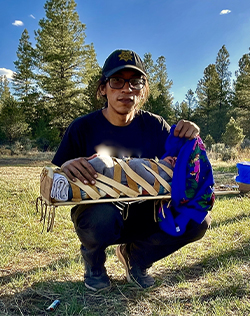 Dondi Begay
Dondi BegayNavajo Forestry Product Industry - Clean-up Advisory Group
Navajo, NM
Ya’ah’teh! My name is Dondi Begay and I participated in the 2021 summer ITEP internship session. My work site was with the Navajo Forestry Products Industries Community Cleanup Advisory Group in Navajo, NM. The ITEP program recognizes the need for educated tribal professionals and provides a huge opportunity for young tribal members to experience the field of environmental science. The ITEP internship program gave me an opportunity to serve my community with the skills and knowledge I have earned as a student in a tangible and meaningful way.
If you are young native student pursing the field of environmental science, I would highly recommend participating in the ITEP program. ITEP is committed to serving tribal nations and addressing the environmental needs of our communities. The ITEP team will make you feel welcomed and at home while you and other interns dip your toes into the world of regulatory science. The program will open many doors to what you previously thought inaccessible and teach you invaluable professional and social skills needed in the workplace. I am grateful for the time I spent as an intern and will continue to build on the knowledge I gained whilst an ITEP intern.
Clarene Davis
 Clarene Davis
Clarene DavisUniversity of Alaska - Fairbanks
Fairbanks, Alaska (Virtual)
My experience with the ITEP internship was ripe with learning opportunities. I learned a lot about air quality and the effects of climate change on indigenous communities. Tribes have historically played an important role in environmental issues including air quality and climate change. Wood-burning stoves and wildfire smoke contribute to poor air quality for many Alaskans. These rankings highlight the importance of collaborating on ideas to enhance Alaskans' air quality. One in four Native infants is hospitalized each year with acute respiratory infections. Substandard housing, overcrowding, poor indoor air quality, lack of indoor plumbing contribute to health problems in some indigenous communities. My objectives for the internship were communication projects: including a Power Point presentation, brochure, flyer, and video. Additionally, I was the guest speaker for Moms Clean Air Force and expressed the message of air quality in rural Alaska. However, the most valuable part learning experience is the passion it gave me about the Alaska Native and the need for indigenous rights including environmental justice for tribes.
As a whole, I believe that this internship was successful in furthering my knowledge of a career in the field of environmental science. I saw the pressure of deadlines, the importance of the value of being a self-motivator. ITEP staff is the people who oversee the academic components of the internship experience. This means helping students develop learning goals, structuring academic reflection for the internship, and monitoring the student's growth and learning. ITEP mentors are encouraged to monitor the student’s progress at the internship site by communicating daily. If you are interested in Indigenous rights and environmental injustice then ITEP is the perfect place to work with EPA and indigenous communities. Indigenous people are the last people on this planet that are still connected to the operating system of Mother Earth. It would be very wise to stop and listen to us because although less than 5% of the population of this planet is of indigenous origin. We hold stewardship of over 50 percent of the planet’s natural resources. Social justice, indigenous rights, human rights, are also the intersection between environmental issues and women’s rights. Therefore, women are the most affected people when it comes to biodiversity laws. Indigenous people’s women and environmental issues intersect. Indigenous women rising to the position of leadership in their community to fight for social injustice, human rights, indigenous rights, and environmental justice. It’s up to each and every one of us to do everything we can to further the agendas for social justice for all. The ITEP internship program can navigate and explore job options, understands and can take the steps necessary to pursue opportunities, and understands how to self-advocate for opportunities in the workplace.
Jeri G. Garfield
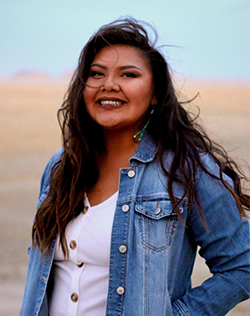 Jeri G. Garfield
Jeri G. GarfieldUniversity of Arizona, Department of Chemical & Environmental Engineering
Tucson, AZ (Virtual)
Yá’á’tééh (Greetings). My name is Jeri Garfield. Kin Yaa’aanii nishlí, Áshįįhí bashishchiin, Bit’áh’nii dashicheii, Kiłichinii eí dashinálí. Akot’ao éí Diné asdzáán nishlí. Interpreting the Diné language, I am of the Towering House People clan, born for the Salt clan, Folding Arms People are my maternal grandparents and Red House People are my paternal grandparents. In this way is how I am a Diné woman. I am a senior in the Bachelor of Public Health program at the Northern Arizona University. I completed the ITEP internship remotely with the University of Arizona, Department of Chemical & Environmental Engineering.
This internship allowed me to enhance my skills and knowledge in environmental-related research. My research title is "Analysis of Extreme Aerosol Events at Mesa Verde, Colorado." This project aimed to identify the weekly, monthly, and interannual trends of PM2.5 extreme events at Mesa Verde, Colorado. I used the Interagency Monitoring of Protected Visual Environments (IMPROVE) monitoring data and Navy Aerosol Analysis and Prediction (NAAPS) chemical transport model to identify the sources of the extreme events. My host site mentors, Dr. Armin Sorooshian and Marisa Elena Gonzalez gave me the tools and guidance to succeed throughout the summer. Through the process, I have been able to learn about the role of fine aerosol particles, specifically particulate matter (PM2.5), and its significant public health and climate concerns. If you have a passion for the environment, it is possible that the ITEP internship might just be for you.
2020 Summer Interns
Amanda Freele
 Amanda Freele
Amanda FreeleHonor the Earth
Duluth, Minnesota (Virtual)
Summer of 2020… what a year, especially for me. My major is in Environmental Engineering. This field of study mainly encompasses water, soil, and air. The Northern Arizona University ITEP program offers a perfectly crafted blend of culture, air quality, and learning from a team that is passionate about the work they do. This was the opportunity that I have been waiting for!
For my ITEP Internship, I worked remotely with the host site Honor the Earth, based in Minnesota. Over the past two months I learned new information and expanded on skills I already possessed. I was in charge of researching information on topics related to fossil fuels to provide educational material for the public. I offered solutions and alternatives to dangerous chemicals being used in refineries. I also learned a lot about particulate matter and air quality monitoring systems through other interns and research. This internship has provided me an experience that cannot be found anywhere else. I got a first-hand look into the tribal communities and environmental activism in Minnesota and Wisconsin while working side-by-side with them on environmental rights issues they are currently facing. I know the work I have done this summer could potentially save lives through advocacy and help communities transition to a greener energy corridor.
The ITEP Internship offers a program truly unique. Not only did this opportunity add value to my career, but it helped shape me as a person. Now I feel confident that I can use my own uniquely creative, critical thinking skills to work through any situation. I would strongly encourage other students to apply and pursue this amazing opportunity with ITEP.
Uziel J. Perez
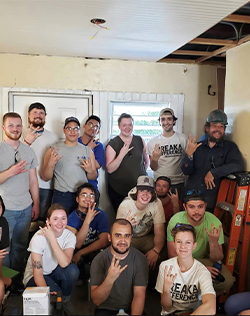 Uziel J. Perez
Uziel J. PerezUniversity of Alaska - Fairbanks
Fairbanks, Alaska
After I worked with ITEP, I gained a great understanding in the field that I am pursuing at my university in Fairbanks Alaska. I got the opportunity to work with such an amazing group of mentors and fellow interns on a matter that is very meaningful in our communities. The fact that I can have an impact on my community while also having fun doing it, is a very big plus for me. Other experiences that I have obtained whilst working with ITEP is a greater sense of professionalism with my work. The mentors that I had on my project really had me thinking critically about how to go about a task. That is something that I did not receive in other work environments. The mentors that put me under their wing are professors that have many years of experience working in this sort of field. That is one of the best things in an internship, getting placed under the supervision of someone who wants to pass on things that they have learned themselves over the course of their professional career. ITEP does a good job at that, all of the institutions that are partnered with ITEP are very welcoming, and only want to help me become a professional person in the given field. It is a program that improves the health of rural communities that lack funding from the government to improve the infrastructure of the community. I truly enjoy helping others, and this gave me the ability to do just that.
Irvin Ledezma
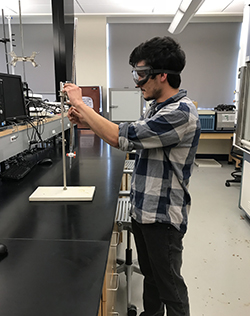 Irvin Ledezma
Irvin LedezmaNorthern Arizona University
Flagstaff, AZ
The host site for my ITEP internship was Northern Arizona University’s project on Cove, located on the Navajo reservation in northeastern Arizona. For background on the host site, extensive uranium mining was conducted on the Navajo Nation, with approximately 30 mines being in close proximity to Cove. While these mines are now abandoned, the contamination from these mining operations are still affecting the health of the local environment and the people who live on the Navajo Nation. Therefore, it is important to know how much excess uranium is in the environment and how is it being ingested by people or animals. My focus on the project was to measure the concentration of uranium and arsenic in soil samples from areas around Cove where livestock are commonly grazing. I prepared samples for analysis on an Inductively Coupled Plasma-Mass Spectrometer (ICP-MS). These samples would also be compared to soil samples from Cameron, Arizona, where uranium mining also occurred. We would also use this soil data and compare it to air quality data from the EPA and other partners with the university. The purpose of collecting this data is to determine if livestock are grazing in areas that have high uranium contamination. If they are, this could be a reason for the increased uranium found in the livestock at Cove. It’s a huge project and I feel honored to play a role in it!
I completed my bachelor’s degree in chemistry in 2018, and I felt certain I wanted to work in the field of environmental chemistry. However, I didn’t have any prior experience in the field. I started my master’s degree in chemistry in 2019 and had the privilege of being selected to work on the Cove host site. Even though the current pandemic shut down travel, the ITEP staff were still very accommodating and I still got to work on soil samples that were collected on the last trip to Cove. I learned a lot more about the environmental issues occurring on the Navajo Nation and I got a unique opportunity to make a difference in the cleanup around Cove. I encourage others to consider an internship with ITEP and learn how to perform meaningful work for the environment and for tribal areas.
Natalia Cachora
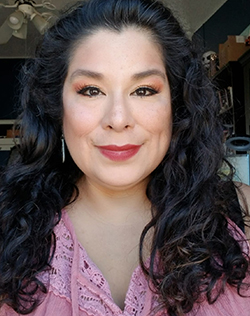 Natalia Cachora
Natalia CachoraUSEPA Region 10
Seattle, Washington (Virtual)
I am a member of the Fort Yuma Quechan Indian Tribe. I am a graduate student at the University of Arizona in the Master’s in Development Practice program, with an emphasis in Tribal Environmental health and justice.
My ITEP internship has been the highlight of my educational career as a graduate student. During my internship I was able to work with 2 amazing organizations that care about the health and wellbeing of Native American and Alaskan Native communities. My host site was EPA Region 10 and my mentor/supervisor is Ms. Kayla Krauss. ITEP and EPA region 10 has provided me with an amazing experience by introducing me to Road Dust management as well as acquainting me to several tribal partners that have concerns with road dust in their communities. And how tribes are working to mitigate these concerns. I also learned from my mentor road dust not only affects Alaskan Tribal communities but throughout the state of Alaska. Managing road dust is essential for reducing the exposure to Particulate Matter (PM) which affects air quality. Not only was I able to learn about road dust through this internship. I also was able to create a PowerPoint presentation explaining to school age youth, air quality as well as describing the effects of particulate matter on health. In this presentation we were able to make a homemade air sensor for these students using petroleum jelly and a paper plate. So, the student can see how clean their air was inside and outside of their home. Opportunities like these are great because this gives us students the experience, we need to enter the workforce prepared. Thank you ITEP staff and Partners for this opportunity!
Hailee Brown
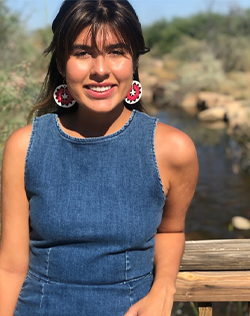 Hailee Brown
Hailee BrownUniversity of Alaska - Fairbanks
Fairbanks, AK (Virtual)
Yá’át’ééh! My name is Hailee Brown. I am Navajo and of the Towering House & Many Goats clans. This summer I was an intern with ITEP NAU at the University of Alaska Fairbanks. I had a wonderful experience being an intern. This summer I learned about Purple Air technology, wildfires in Alaska, and Native Alaskan communities’ air quality and public health. While working in Arizona remotely, I worked on various projects related to wildfires in rural Native Alaskan communities. I specifically focused on learning about and utilizing Purple Air technology to monitor the air quality in different communities. To familiarize myself with this technology I set up two Purple Air monitors, one on the Navajo Nation in my hometown of Coppermine, Arizona and another in Phoenix, Arizona. I encourage others to research Purple Air technology and to learn about how to use the devices to measure the air quality in your community.
Throughout this summer, I have learned how the air around us affects our overall health. Wildfires and dust can seriously interfere with us as humans breathing healthy air. And like my dad always says- good health is great wealth! So, monitoring the air quality in tribal communities is very important in the quest to improve tribal public health and wellness. This is my second summer being an ITEP intern. I encourage other students to apply for an ITEP internship as it is a great opportunity to gain hands-on experience working with tribal communities, do meaningful work, work with new technology, and learn about new cultures and people. I could not recommend the internship enough- apply!
Jessica Smith
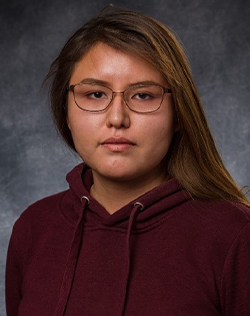 Jessica Smith
Jessica SmithInstitute for Tribal Environmental Professionals (ITEP)
Flagstaff, AZ (Virtual)
I am from Brimhall Nizhoni, NM and graduated at Crownpoint High School. I am continuing my education at Fort Lewis College. My major is Biology and minor in Studio Art and Environmental Science.
During my internship, I learned new ways of communication to groups of people. There are many ITEP staff that are working on keeping the air quality healthy to local communities. They are committed to helping their community especially to the reservation where there is lack of internet connection. I was happy to be part of the ITEP projects like the PurpleAir. I was assigned project to overlook QREST and PurpleAir, both are technologies are available for tribal staff to use. My objective is to first see the technical difficulties in the networking before introducing it to tribes. This internship is a good experience for undergraduate and graduate students, who are interested in environmental health for the public. Not only is ITEP internship is good career experience, but they also include Native American background in a work experience and she strongly encourage future ITEP interns to join in their projects and be involve with the community. I have helped her community with the ITEP’s monitor, PurpleAir, which is an outdoor or indoor device that does online streaming on the air quality.
Josette Vigil
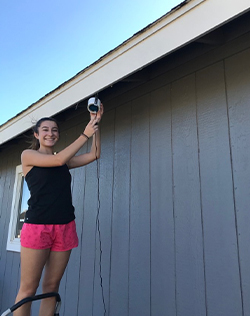 Josette Vigil
Josette VigilNez Perce Tribe
Lapwai, Idaho (Virtual)
Hi! My name is Josette Vigil, a mechanical engineering student at Northern Arizona University. My interest in tribal work was sparked by my Ute Mountain Ute heritage, and my professional interest lies with sustainable agricultural design.
As an ITEP intern working with the Nez Perce host site, I learned so much about professionalism, remote outreach, and collaboration. I developed my professional communication skills through interagency, and even international meetings regarding air quality, education, sensing networks, and equipment. While I am very passionate about tribal work and environmental issues, I was concerned about the literal application of my work to my personal career goals. However, these doubts were quickly lifted. Not only is any professional experience for a student valuable, but I gained hands-on experience with crucial professional skills that are valuable in any discipline. Practicing community outreach, writing, and effective communication on projects are just a few examples of what this internship entailed. My mentors and superiors were all extremely positive and helpful. Their support and model of professionalism strongly encouraged me to pursue my passion of tribal environmental work. Also, they helped make this a very enjoyable summer. I loved working on outreach projects and getting hands-on experience with an air sensor. My favorite part of the internship was learning about the Nez Perce, or Nimiipuu, ways of life. Getting to know more about the Nez Perce tribe was a really enlightening experience for me, since most of my previous tribal exposure has been in the Southwest. I got to learn about different cultural practices and traditions, and even a little bit of language! I would highly recommend this experience to anyone looking to get involved with tribal environmental work. Gaining new insight into the professional world and exposure to the issues facing different regions has inspired and motivated me to persist in my educational and professional efforts, and through this position I was able to spark connections for future research and work.
2019 Summer Interns
Sophie Burgess
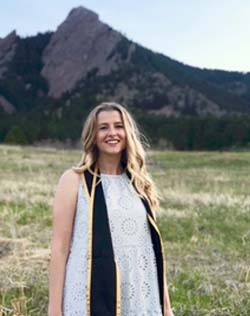 Sophie Burgess
Sophie BurgessBig Pine Paiute Tribe of Owens
Big Pine, CA
After completing a major in Environmental Design, I found that I was still looking for ways to peruse additional interests that I had in college that fell outside of my major. During my senior year, I took an environmental justice class and became very passionate about the subject. However, I never got to explore this interest as much as I would have liked to. When I heard about the ITEP position at the Big Pine Paiute Tribe of Owens Valley, I was excited to combine my passions of environmental justice, community outreach, and research work. The past eight weeks that I have spent in this position have been incredibly informative, unique, and have made for an unforgettable experience. During my time here I have had the chance to monitor and collect weather and particulate matter data for the Big Pine Air Quality Program, in addition to working with the youth of Big Pine. I was able to create and lead several informative air quality activities with the Big Pine Education Center and the Owens Valley Indian Water Commission Environmental Youth Camp. I have also had the opportunity to explore various projects and research that the surrounding community is working on, and have been able to see the direct effects that climate change is having on this area. Overall, this experience has taught me the power and resiliency of small communities and their battle with multifaceted, climate change related issues. I have learned so much during my time here and am so grateful for the opportunity to work alongside such dedicated and inspirational professionals. Additionally, I couldn’t have been in a more stunning location- nestled between the Eastern Sierra and the White Mountains, the Big Pine area has limitless access to any outdoor recreation you could wish for. I hope to be back in this insanely beautiful area soon! I would highly recommend this opportunity to anyone considering it, and am excited and passionate about incorporating this type of work into my future career.
Darcy Emm
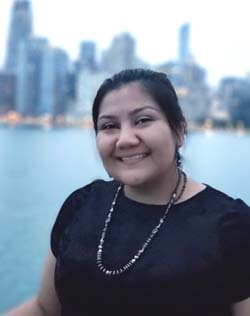 Darcy Emm
Darcy EmmEPA Region 9
San Francisco, CA
For this ITEP Internship through EPA Region 9, I was placed in the air permitting office. My summer projects included air modeling of minor sources under the Air Permitting Program on Tribal Lands and the Identification of Possible Minor Sources of Air Pollution on Tribal Lands. This internship with the EPA offered a professional environment that I previously had no experience with. It was very cool to share my culture, experience and knowledge of native people with them on a professional basis. The people at the EPA routinely worked with tribes but this was usually just over the phone or email correspondence. I believe that having a native intern benefitted them as well because they were able to ask questions and see how native people think and interact with other nonnative people.
Nataani Hanley-Moraga
 Nataani Hanley-Moraga
Nataani Hanley-MoragaNavajo Nation EPA
Fort Defiance, AZ
During this past summer I had the opportunity to work for my tribe under the Navajo Nation EPA Air Quality Control Program (AQCP). I was brought on to assist in their Open Burn project, which was to assist in making a video to disperse amongst chapter and be used during their presentations to the community. I was also in charge of assisting with their day-to-day responsibilities and see how their program functioned.
This internship has provided opportunities, experiences, and knowledge that can not be attained within a classroom. It gives you a first-hand look into a tribe and its members of the community. You can get an idea of their way of life, their issues, and see their land. Through working for the AQCP, I saw places of my reservation I have never been to. For my project I was taken to Canyon de Chelly and hiked down to see ruins left by our ancestors, Navajo monument, and Spider Rock.
Throughout my internship coworkers gave me insightful knowledge of the community, language, and history. All the while still teaching me about what their responsibilities are. Things like monitoring air quality, indoor and outdoor. I also got an inside look of a gas compressing station and getting a run-down of its history. These are things that you wouldn’t be able to learn through lectures or videos. You also get the opportunity to form connections with people or important resources that could assist you as you continue your way through school.
By the end of my internship I had learned more than I originally thought I would. I also saw a whole lot more than I thought I would too. I value my time on the reservation and working with one of the best tribal air quality programs. They have given me an experience that I won’t forget and knowledge that I can use as I continue to pursue my degree and career. I highly recommend an internship with ITEP, as it can take you places you have never been. As well as give you an inside look at your tribe’s issues or other tribes issues that interest you. You will leave more knowledgeable, prepared about your field of interest, and connections that will last and assist you in your education and career.
Julia Hnilicka
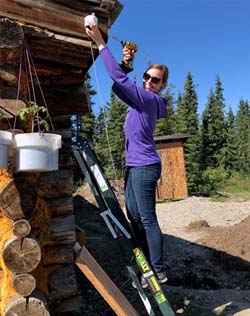 Julia Hnilicka
Julia HnilickaUniversity of Alaska Fairbanks
Fairbanks, AK
Summer of 2019 will go down in Alaskan history books as one of the hottest (so far) and smokiest summers on record. With my ITEP internship I got to be part of that history! As a lifelong Alaskan resident I was proud to work with ITEP and the University of Alaska Fairbanks to place air quality monitors in rural parts of the state. I was able to fly to and drive around some of the most beautiful parts of my home that would have been cost prohibitive on a student budget. I was also on a mission to bring access to information and data to rural residents that they haven’t had before.
Air quality is an important part of healthy lives and although Alaska is pretty free of human made air pollution, wildfire smoke can have huge health impacts. Our elders in Alaska are particularly susceptible to health impacts when it comes to smoke or dust inhalation. Our wildfire seasons can be long and intense, the more data we can compile and use for the future, the bigger positive health benefit we can create.
Often times urban centers are monitored for air quality, but my project focused on rural Alaska which means that I got to see some very remote communities in breathtaking locations. I am so glad that ITEP partnered with UAF on a pilot project and I got to be the exploratory agent. The flexibility and trust that both entities afforded me was exciting and helped me grow as not only a researcher but also as a communicator and traveler.
I would strongly encourage other students to apply and work with ITEP, not only are they focused on exciting projects, but they also take special care and consideration with their interns. I will look back on the Summer of 2019 as not only hot and smoky, but also incredibly impactful on my education and future.
Alex Hufft
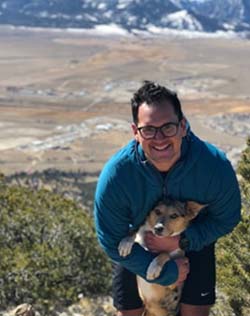 Alex Hufft
Alex HufftUS HUD Northern Plains Office
Denver. CO
My ITEP internship with the U.S. Department of Housing and Urban Development (HUD) is one that has most definitely shaped me and my ambitions for future career opportunities. What was so great about ITEP and their staff is their investment in not only their program, but also in the interns who are participating. There was never a time where I was left wondering with a question or concern. Any time I emailed the staff, they were quick to respond and almost always had the answer, and if they didn’t they were figuring it out alongside you. I think another great thing about my ITEP experience is in regards to the internships/host sites they choose. When reading the descriptions of each host site you realize that they are not just going to be a job you go through the motions at every single day, but they are roles that foster independent thinking, research and continual learning. I believe anytime you are put into a position like that you’re going to enjoy your time a little more and come out feeling more positive about it all.
My time spent with HUD’s Office of Native American Programs in Denver, CO was a great exposure to the civil service roles that a federal entity possesses. And I am not sure I’d ever get that exposure if it wasn’t for the opportunity the ITEP has created for me and all the other individuals who have gone through this program. I also think this program allows you to see opportunities that are out in the world that you may have never known existed. Whether that be a specific role within a company or even that a company or organization exists to do a very specific thing, especially in regards to Native American communities. I think at the end of the day that is what is so great about ITEP. That there are these tribal initiatives and jobs out there to better serve indigenous communities and ITEP is trying to help establish awareness by providing opportunities within those initiatives and jobs for graduate and college aged individuals.
Winslow Lewis
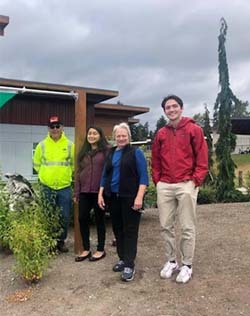 Winslow Lewis
Winslow LewisTribal Healthy Homes Network
Tulalip, WA
My name is Winslow Lewis and I recently finished my 2019 Institute for Environmental Professionals Internship (ITEP) with Tribal Healthy Homes Network in Tulalip, WA. Tribal Healthy Homes Network is a nonprofit organization that that brings together tribal environmental, public health, and housing practitioners to identify and employ effective methods for reducing indoor air contaminants in tribal homes. During this internship, I was asked to contribute to the renewal of the organizations Tribal Indoor Air Funding Directory, a guide that compiles resources that can be used by tribes or tribal members to address indoor air issues nationwide. This was designed to alleviate the indoor air quality issues faced by many indigenous communities through connecting tribes with the grants and loans best suited for the project they’d like to pursue. The majority of my work involved compiling the content of this website, communicating with grantors to ensure the accuracy of the information we’ve compiled, and contributing to the design and functionality of the database we’ve built.
For me, my ITEP internship offered a unique experience to work for an organization that make the most out of the limited resources we had available. The people at my host organization essentially offered me a masterclass in community organizing, community-based research, and project management. I was able to absorb this information and grow within my position because I approached this project with the clear goal of taking on responsibilities and learning from the approach of my host organization. While the majority of internships can revolve around clerical work and limited responsibility, it is my feeling that ITEP internships prepared me to lead within this field, by giving me a taste of what effective, community-oriented work should look like. I am incredibly grateful to have had this experience and am looking forward to continuing to develop as a tribal environmental leader moving forward.
Aracely Navarro
 Aracely Navarro
Aracely NavarroAlaska Community Action on Toxics
Anchorage, AK
The summer of 2019 I interned with an organization named the Alaska Community Action on Toxics. This non-profit organization focuses on issues of environmental health and environmental justice. Their work is diverse and they collaborate with a lot of local stakeholders around Alaska regarding issues of water quality, air quality, soil quality, voter rights, and advocate for policy change. In addition, they run their own organic gardening program where they pair people with land and people without to create local organic gardens. The staff of ACAT are all lovely people and I really enjoyed my time working with them. They were beyond generous, loving, helpful, driven and very passionate about the work that they are doing. I learned so much this summer about Alaska and the issues that the local people are facing in terms of climate change and contamination around the state. But, I also learned about the multiple ways that the community can come together and organize for a safer and cleaner world. This was an amazing experience and I wish I could have been with ACAT longer!
Caressa Nguyen
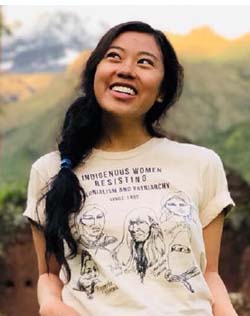 Caressa Nguyen
Caressa NguyenTribal Healthy Homes Network
Tulalip, WA
My ITEP Internship was with the Tribal Healthy Homes Network and the Tulalip Tribes on the Tulalip reservation, located approximately 40 minutes north of Seattle. In 2017, Tribal Healthy Homes Network developed a Tribal Guide to Indoor Air Quality (IAQ) Funding that had not been updated since. This summer 2019 was spent developing a searchable directory for finding IAQ funding to be used by Native Alaskan tribes and tribes nationally. My role in developing this new, searchable guide was conducting qualitative research by creating a survey that was sent to tribes and organizations. The feedback we received through the survey results were utilized to design a user-friendly resource guide incorporating features and search methods most useful for tribes. This information was used in designing the online funding directory, which our team developed mock-ups that I presented to the Environmental Protection Agency for feedback. To ensure that this guide is as user-friendly as possible for tribes, I was tasked with creating a Tribal Review Panel that gave me the opportunity to work directly with tribes across the nation and Alaska Native villages in the development of this resource, and learn about the issues they face with housing and indoor air quality.
My ITEP internship has been spent doing meaningful work that can be beneficial for all of Indian Country and Native Alaskans. Working closely with my host site mentor and fellow ITEP intern has enabled me to grow as a professional and in my role on a team. Prior to this internship, I had minimal knowledge in Indoor Air Quality, but held a deep desire to expand my knowledge of Indigenous environmental issues. With a background in natural resource management, agroecology, and water policy, I feel that I can approach issues with a more well-rounded and holistic understanding with my newly acquired knowledge in air quality. I would highly recommend an ITEP internship, for those seeking to do meaningful work.
Kaila Stein
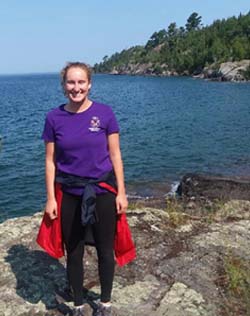 Kaila Stein
Kaila SteinKeweenaw Bay Indian Community
Keweenaw Bay Indian Community
My experience with ITEP was very different than a typical internship. Not only did I have the opportunity to work in an office setting, I also had the chance to do a variety of work in the field, get to know the local area, and learn about Ojibwa culture by attending many cultural events throughout my summer. This was a rich, varied experience where I was able to get a taste for many different types of environmental work. I had the opportunity to work on a variety of different topics including air quality, water quality, wildlife, community outreach, ecology, and more.
This summer, I did a lot of field work. Since the Upper Peninsula of Michigan is situated on Lake Superior, a lot of this field work had to do with the lake. I went out on the lake to do water sampling, went to the Huron Islands to inspect the state of the national wildlife refuge on the island, and went to do wild rice sampling, among many other experiences. I also learned about the local culture of the Ojibwa people who are native to the area. Some of my coworkers were native and were very kind to teach me about their history and traditions. I also attended the tribe’s Pow Wow in July where I was able to see the traditional dances of the tribe as well as beautiful regalia that the tribal members wore.
In addition, while I was in this part of the U.S. that I had never been to before, I was able to experience a different way of life than what I was used to. For example, before this summer, I had never seriously considered foraging. However, I learned about the abundance of wild food that grows freely and how to collect it. I went to pick blueberries, thimbleberries, and raspberries. These berries grew so rampantly in the area that while I was out in the field working on projects, I could pick a few berries as I walked for a quick snack. In addition, since I lived right on Lake Superior, I had many adventures this summer out on the lake and in the mountains around it. This internship was a great experience, I got to see a beautiful part of the United States that I previously did not know about while also working to protect the natural beauty of Lake Superior.
Xaviera Stevens
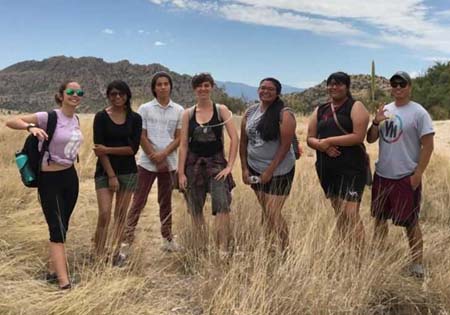 Xaviera Stevens
Xaviera StevensSouthwest Environmental Health Sciences Center at The University of Arizona
Tucson, AZ
I worked in the Southwest Environmental Health Sciences Center at the University of Arizona. The focus of my internship was education outreach and environmental summer camps. I was able to help create the curriculum and schedule for one of the programs and help to teach some of the activities for some of the other summer camps. I worked in and out of an office and I was able to work pretty closely with some of the students. Most of the summer camp programs involved teaching students about environmental health, introducing them to campus departments as well as resources, and bringing in guest speakers. I spent two months learning about environmental health and ways of teaching the information I was learning to several different age groups. I was able to observe and learn some tools for helping a group of students to connect and learn better. I was also able to get to know my co-workers, build relationships with them, and explore some of the beauty that Tucson has to offer. I learned a lot more about the tribes in the surrounding area and how the University of Arizona interacts with them. Through the process of interacting with Native Americans in the southwest, I also learned more about their cultures and specific environmental health issues that they deal with. Getting this internship through ITEP allowed me to apply to several different places at once and gave me a lot of practice with interviews. Going through ITEP also allowed me to focus more on my work and experience in Tucson because I did not have to worry about making sure I could pay for rent and the flights to and from Tucson. At the end of the two months, Tucson has grown on me and I feel more confident that no matter where I go to start my career I will be able to land on my feet and find people to learn from and connect to.
Noah Williams
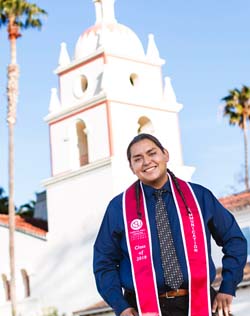 Noah Williams
Noah WilliamsNorth Central Climate Adaptation Center
Boulder, CO
Hello, my name is Noah Williams, I am Paiute from Bishop, CA. I recently completed my undergraduate studies receiving my B.A. in Communication at California State University Channel Islands in May 2019. This Summer I had the privilege of being selected as an ITEP summer intern at the North Central Climate Adaptation Science Center (NC CASC) at CU Boulder. NC CASC is one of eight regional climate centers under the Department of Interior that specialize in climate adaptation planning by fostering new and innovated science directed towards Air, Land and Water. I worked directly with NC CASC’s Tribal Resilience Liaison; I was tasked with supporting ongoing tribal climate adaptation projects, produce website articles and compose/design the first-ever tribal climate newsletter released by NC CASC. I also had the opportunity to participate in consortium partner meeting, tribal climate workshops, joint-stakeholder committee meeting and site visits to reservations within the North Central region. These opportunities allowed me to network with tribal professionals and learn firsthand from natural resource managers who are on the frontlines of combating climate change on tribal communities.
The ITEP internship was an opportunity for me to connect with tribal leaders, learn about on-going climate issues of 31 federally recognized tribes in the North Central region while learning how to conduct myself in a professional setting. I have learned much in the 8 weeks working with NC CASC and developed skills that are fundamental to my future academic and career goals. The transition from student to a young professional began with the ITEP internship, I highly recommend any upcoming graduate seeking a professional experience in environmental science to apply and pursue this great opportunity.
2018 Summer Interns
Darrien Nikkole Benally
 Darrien Nikkole Benally
Darrien Nikkole BenallyTulalip Tribes and Tribal Healthy Homes Network
Tulalip, WA
This summer I worked with the Tulalip Tribes and the Tribal Healthy Homes network in Tulalip, WA. The Tulalip tribes are located along the Puget Sound region. During the summer of 2017, there were severe wildfire episodes all along the west coast. The wildfire smoke created hazardous conditions at Tulalip because the smoke from the fires was centralized over the Tulalip bay. This internship was focused on creating a response network in the event that wildfires will likely occur again and the resulting wood smoke could impact the region again.
My role as a student intern was to create qualitative surveys to interview various program managers at Tulalip administration. These surveys asked about air quality index familiarity and health impacts related to poor air quality and wood smoke. There were two more surveys created which had similar questions, but were used for different tribal nations and Tulalip community members. These surveys will be used to create this response network for Tulalip in the event of another severe wildfire season.
I enjoyed working with the Tulalip Tribes and the Tribal Healthy Homes network because there was a lot of support from my host site mentor. I feel this experience has helped me grow academically and professionally. I learned a lot about Indigenous environmental issues and how to create a solution to these issues using a tribally competent framework. I enjoyed working with the members of the Tulalip community because they were willing to help in anyway they could and were interested in air quality topics. This experience helped me take my classroom learning out in to the field and gave me a great foundation to build my professional career on. I would encourage anyone to apply to this program. Without this program, I would have not been able to work outside of state and build my professional skill set.
Megan Kerstein
 Megan Kerstein
Megan KersteinNez Perce Tribe
Lapwai, ID
My name is Megan Kerstein, and I am from Chicago, IL. I am currently a master’s student studying biomedical sciences at Boston University. As the Nez Perce Tribe Air Quality Office Education and Outreach Intern, I had a fantastic summer experience! I spent a large portion of the summer presenting to children at area libraries, summer schools, and the Lapwai Boys and Girls Club. I often discussed the intersection of health and the environment with an emphasis on the respiratory system and how air quality impacts respiratory health. I came up with engaging activities for the children, including making a mini lung model and making rockets that we then had the opportunity to test fly. It was really thrilling to see how passionate the children were about science! I also worked various outreach events in the community, manning the air quality booth and answering questions from community members. I also assisted with the EPA CASTNET air quality monitoring network site in Kamiah, ID, where I helped change out air filters on the equipment. I had other amazing opportunities during my time as an ITEP intern, including touring the Dworshak National Fish Hatchery, assisting with a forestry camp for local 6th graders, handling Pacific lampreys as part of a tribal conservation project, and shadowing a physician at the Nez Perce health clinic, Nimiipuu Health. Every day during my internship I learned something new, ranging from learning more about the Nez Perce culture and language to learning how to effectively convey health information during my presentations with children. I am very grateful to ITEP and the Nez Perce Tribe for my summer experience, and I will use all the skills I learned as I go forward in my career in health and medicine.
Michelle Pawlow
 Michelle Pawlow
Michelle PawlowNorthern Cheyenne Tribe
Lame Deer, MT
I am so grateful to have had the opportunity to be an ITEP intern for the Northern Cheyenne Tribe in Lame Deer, Montana for the summer of 2018. As an environmental engineering student at the University of Michigan, this experience has been especially beneficial to my growth as student and working professional within the field of air quality and environmental policy. As an intern, I had the opportunity to work with staff at the air monitoring sites, testing for the concentration of common air pollutants output by the nearby power plant. I also was able to complete HAZWOPER training, create educational indoor air quality materials for community members, and even help care for the local prairie dog population. I was really fortunate to have had a variety of different tasks each day, and I loved having the opportunity to leave the office setting and do work in the field.
I had no idea what to expect when I began working in Montana, and certainly was not aware of how much this experience would impact my future decisions. In just eight weeks I have made lasting friendships and taken weekend trips that I will remember for the rest of my life. I never expected this internship experience to provide so much more for me than just a job opportunity. While I learned so much about air quality and tribal health, I also was able to travel to so many historic sites and parks with new friends, including hiking in Yellowstone, attending a wedding in Bozeman, horseback riding in Busby, and even taking a road trip to Mt. Rushmore. Each week of work provided valuable learning experiences, and each weekend a new adventure.
I highly recommend anyone interested to apply for the ITEP internship. It is an amazing opportunity that allows you to learn not just about your work program, but also about yourself. As I continue to complete my education and move forward towards a career, I now will seek out job opportunities that allow me to spend time outdoors conducting field research or doing consulting work. I know I will continue to reflect on my experiences from this summer for the rest of my life, and couldn’t be more grateful to have been able to work as an ITEP intern for the Northern Cheyenne.
Sanober Mirza
 Sanober Mirza
Sanober MirzaGila River Indian Community
Chandler, AZ
For my ITEP internship, I worked with the Gila River Indian Community’s Air Quality Program, where I helped with outreach about the threats from extreme dust events. I was responsible for writing a mitigation plan for extreme dust events to be submitted to the Environmental Protection Agency. This mitigation plan focused heavily on public notification and outreach. I also helped Air Quality employees with ambient air quality monitoring through site checks as well as compliance and enforcement through source inspections. I helped Department of Environmental Quality employees with outreach events, while learning more about the Community and its relation to the natural landscape.
Overall, I gained many different skills from this internship experience. I learned technical skills related to air quality monitoring and saw firsthand how meeting policy requirements are carried out on the ground. I also got professional experience working with DEQ employees, Community members, stakeholders in agricultural and industry, Arizona Department of Environmental Quality, and the EPA. Doing outreach in a Tribal community taught me about communicating issues related to the natural environment and I learned so much about the history and traditional culture of the Akimel O’otham and Pee Posh people. I am very grateful to have been welcomed into the Community and have gotten this experience.
Sherralynn Sneezer
 Sherralynn Sneezer
Sherralynn SneezerNavajo Nation EPA
Fort Defiance, AZ
Hello, my name is Sherralyn Sneezer, and I am Navajo from Shonto, AZ. I am about to begin my senior year at Dartmouth College in Hanover, NH. This is my second year participating the ITEP internship program with NAU, and I enjoyed it tremendously. I interned with the Navajo Nation EPA Air Quality Control Program in Fort Defiance, AZ. My ongoing project was making a video about how to operate the Navajo Hybrid Stove manufactured by Woodstock Soapstone. We visited a few homes with the stove, so that I could record the operation of the stove. While I was in the process of making the video, I was also able to do field work with the Environmental Technician and Environmental Specialist. Often, we went to the air quality monitoring site in Nazlini to install and pick-up filters from the air monitors. My mentors made it a priority to make sure I was learning how to operate the monitors and download data. I was able to help troubleshoot with the technician to figure out why one of the monitors was not operating properly. I enjoyed working with my hands, learning more about the monitors, and problem-solving. We also travelled to Shiprock to do Zero-Span-Precision calibrations to ensure the monitors were functioning correctly. The monitors at Shiprock were more complex than the monitors in Nazlini. Once again, my mentors worked to explain to me how the monitors functioned and let me download the data. In addition to field work, we also focused on outreach, and teaching people about the importance of air quality. A couple of times, we went to Whiterock to teach high school students about air quality and let them use our portable air quality monitors. I really enjoyed being able to talk about air quality with the students. I also had the privilege of going on inspections of the Window Rock and Whiterock Compressor Stations with the Operating Permits Program. We toured the facilities and the workers made it a priority to ensure I understand how the facilities operated. I was able to see first-hand how the Operating Permits Program made sure that large emitters of air pollution were in compliance with air quality standards and their permits were correct. The experience and knowledge I gained is fundamental for my growth and figuring out what type of career I will have in the future. Through the ITEP internship program, I have learned and grown immensely; furthermore, I was able to apply knowledge from the classroom to my experiences, making the concepts more salient. I strongly encourage students to apply to the ITEP internship program, because it is a great opportunity to work with Indigenous people on environmental issues and gain valuable experience.
Zachary Frieband
 Zachary Frieband
Zachary FriebandUS EPA Office of Atmospheric Programs
Washington, DC
My name is Zachary Frieband and I’m currently an undergraduate student studying Environmental Health and Neuroscience at Colorado State University. I had the privilege of being selected as a 2018 ITEP intern and spent my time working for the U.S. Environmental Protection Agency (EPA), Office of Atmospheric Programs (OAP) in Washington, D.C. During my eight-week internship, I collaborated with individuals in two OAP divisions: the Clean Air Markets Division (CAMD) and the Climate Change Division (CCD). Within CAMD, I worked closely with the team running the Clean Air Status and Trends Network (CASTNET). CASTNET is a network that measures ambient air pollution by utilizing 96 monitoring sites across the United States, six of which are located on tribal lands. I was tasked with creating a poster, presented at the National Ambient Air Monitoring Conference, that highlighted air quality and deposition trends at these tribal sites. My focus in CCD was to research how the culture and lifestyle of various tribal communities will be impacted by changing climate.
I would strongly encourage any interested students to apply for this internship. Not only have I met like-minded professionals who were eager to help me at every step, I have also become more aware of ongoing tribal issues. Prior to this internship I had little experience with tribal communities. Now that my internship has finished, I’ve come to realize just how important it is to work with tribes in order to form partnerships that benefit all parties involved.
Zaahir Howard
 Zaahir Howard
Zaahir HowardAlaska Community Action on Toxics
Anchorage, AK
Working as an intern with Alaska Community Action on Toxics (ACAT) this summer in Anchorage, Alaska was extremely gratifying and certainly a definitive step in my journey as a college graduate. The responsibilities I was given throughout the 8 weeks were instrumental in helping me fine tune my professional interest in toxicology. Some of the awesome experience I gained were with: requesting of information under the Freedom of Information Act, literature review of sensitive information regarding toxic emissions from facilities within the oil and gas facilities on the North Slope Borough, AK, learning how to use EPA online air quality monitoring tools and troubleshooting through building an air quality sampling bucket. These have all been part of an impactful mission to fight for Native American environmental justice.
My desire to get involved with an environmental toxicology led me to ITEP to work on projects geared towards improving Native American tribal air quality, and through these projects, I have generated a deeper passion for work in food toxicology. Although I went to work with ACAT for tribal air quality, I was able to learn about other aspects of their organization such as their Yarducopia gardens projects and other research relating to subsistence diets and soil toxins and the like, which are all very relevant to food toxicology.
An important lesson I learned that I wish to pass onto future interns is that problems can be enormously overwhelming, but the biggest hurdle is expressing your interests and getting started because there are always people that are in need of a passionate helper especially with environmental justice. Also, it discovered that starting in one spot does not mean I have to start over somewhere else as I develop new or deeper interest; it means the exact opposite. Starting somewhere is the only way we can make progress regardless of how our career may change later. Finally, the tons I have learned about environmental toxicology have augmented my interests and future endeavors in food science and human nutrition. I am excited to stay connected with ACAT and ITEP get involved where I can. I also will undoubtedly be working with more non-profit organizations in the future.
2017 Summer Interns
Elise Adams
 Elise Adams
Elise AdamsQawalangin Tribe of Unalaska
Unalaska, AK
I was privileged to be one of the ITEP interns for the summer of 2017. For my internship I worked with the Qawalangin Tribe on the island of Unalaska, Alaska. My time was split between field work on Unalaska and lab work in Flagstaff, Arizona where I am currently a graduate student at Northern Arizona University in the Biological Sciences Department. I had a wonderful experience as an ITEP intern. This internship made it possible for me to complete the field work portion of my Master’s project looking at PCB contamination in the Aleutian/Bering Sea Region of Alaska and distinguishing between local sources of contamination from formerly used defense sites and contamination coming up to the Arctic via global distillation. I loved working closely with the indigenous people of Unalaska on work that has important local and broad implications. It has opened the doors for future opportunities and collaborations. I love to travel and experience new things. I got to have the experience of a lifetime this summer spending time in an area that not many people see and doing things that not many people get to do. The ITEP staff as well as my host site took great care of me and wanted me to succeed. This internship has allowed me to grow both professionally and personally. I’m grateful for the opportunities this internship has provided.
Hailee Brown
 Hailee Brown
Hailee BrownUniversity of Arizona, College of Pharmacy, Southwest Environmental Health Sciences Center
Tucson, AZ
Yá’át’ééh! My name is Hailee Brown. I am Navajo and of the Towering House & Many Goats clans. This summer I was an intern through ITEP NAU at the University of Arizona, College of Pharmacy, Southwest Environmental Health Sciences Center (SWEHSC). I had a great experience at SWEHSC as I learned a lot about being a professional, understanding environmental health, and working in Indian Country. Throughout my eight-week internship there was never a dull moment as SWEHSC has many ongoing collaborations and projects. I traveled a lot attending outreach events, meetings, and research sessions throughout Arizona. SWEHSC collaborates directly with tribes as well as indigenous organizations throughout Arizona. Additionally, SWEHSC has strong ties with the Native American organizations on campus. Throughout the summer, I worked on organizing outreach events, planning presentations, and researching data concerning environmental health. SWEHSC recognizes and researches the intersection between indigeneity and environmental science. Some of the topics I focused on this summer included: air quality, asthma, sun-safety, oil spills, toxicology, education, environmental policy, and traditional tribal teachings. The ITEP organization was very supportive and helpful of my work with SWEHSC. I encourage other students to apply for an ITEP internship as they will have very memorable experiences and gain valuable professional skills.
Steven Chischilly Jr.
 Steven Chischilly Jr.
Steven Chischilly Jr.Pechanga Environmental Department
Temecula, CA
My internship experience was impeccable. Through ITEP I discovered other ascending tribal programs that are committed to the betterment of the natural systems. I extremely enjoyed the ability to move to another location, take up a task I am passionate about and meet other friendly goal oriented people. Experiencing the new location opened up my mind to new possibilities for my career. I got a taste of an employment opportunity that is incredibly viable for me.
The Pechanga Reservation is beautiful and a great bit of serenity nestled just outside of the urban community. The tribe has built itself up to a mighty position. The environmental department is always welcoming and has never failed to include me on important matters that surrounded the air program. Their input and conversations keep you well informed and any uncertainties are quickly sorted out in a friendly fashion.
The biggest takeaway from the Pechanga community is their focus on the youth. I was included in many activities that surrounded solely around the youth. It was very refreshing to see. I would not have traded the experience with ITEP and Pechanga for any other, it was an experience that will definitely leave an impression on me for the rest of my career.
Shaun Hudson
 Shaun Hudson
Shaun HudsonHopi Environmental Protection Office
Kykotsmovi, AZ
My name is Shaun Hudson. I’m a Navajo from a small community in Tuba City. I am a Graduate Student majoring in Climate Science and Solutions at Northern Arizona University in Flagstaff Arizona. I currently completed an internship with the Hopi Environmental Protection Office in Kykotsmovi which is a small community on the Hopi Reservation. My duties included conducting studies involving environmental health studies with random home sites around the reservation. My study was a collaboration project with the University of Arizona School of Public Health which addresses environmental health disparities (particulate matter, arsenic, and uranium), evaluating environmental risk and water quality (locally and regionally), and observe the potential leakage of uranium and heavy metal waste from local landfills which could impact community health.
I have always been interested in preserving and protecting our natural resources on Native American lands. ITEP has given me the opportunity to expand on my interests working with the Hopi Tribe and allowing myself to progress in a field that I have been interested in since I’ve entered the environmental science program at NAU. Working with ITEP and the Hopi Tribe has given me the experience necessary to succeed in tribal environmental protection as well as becoming knowledgeable with the procedures in tribal environmental policy. Using the knowledge obtained from my graduate year at Northern Arizona University, I was able to utilize my education and have an impact on the orders and concepts with the Hopi EPA. This internship has given me the confidence to succeed in the ever changing environmental issues surrounding Native American lands.
Melanie Rose Keil
 Melanie Rose Keil
Melanie Rose KeilBig Pine Paiute Tribe of the Owens Valley
Big Pine, CA
As an intern for the Environmental Department of the Big Pine Paiute Tribe of the Owens Valley, I spent the majority of my time conducting independent online research to develop curriculum for air quality and climate change environmental education outreach activities. I created lesson plans, worksheets, acquired, made, and tested materials for two hands-on, science based educational activities which I presented to tribal youth attending a summer session at the Tribal Education Center. My other major activity was planning and implementing a one-day field trip seminar designed to further tribal knowledge of local climate change vulnerabilities, mitigation, adaptation, and survival strategies. Additionally, on the technical side of things, I helped set up, take down and perform regular maintenance on the Tribe’s Emergency Beta Attenuation Monitor. I also helped to take down a meteorological station tower for troubleshooting and helped with the installation and set-up of a webcam that will eventually be used for live stream monitoring of air quality on the reservation. The internship gave me an idea of what working for a Tribal Department is like on daily basis and also provided me an opportunity to improve my interpersonal relationship skills and self-direction especially concerning time management and public speaking skills.
Natalie Shaw
 Natalie Shaw
Natalie ShawCentral Arizona Project
Phoenix, AZ
During my time as an intern at the Central Arizona Project (CAP) in Phoenix, Arizona I had various opportunities to apply my knowledge, in addition to opportunities to further expand it. As a soon-to-be graduate student, this had been especially beneficial to my growth as student and professional within the field of environmental science and policy. Throughout my internship, I was able to network with other Native American professionals in addition to non-native professionals that work in various fields of work. Some of my work focused on water availability to Tribes with claims to Colorado River water and the consideration of various scenarios of water use and their impacts to water users of this important body of water. I worked with some amazing people who mentored me during my internship and I hope to remain in contact with. Unlike a classroom setting, where learning is mainly based off of textbook and lecture learning, an internship teaches you through experience, experience that you can carry with you to future careers or internships. You also aren’t limited to work on one topic, and you get the chance to branch out and learn from other different topics. During my internship, I not only worked on a scenario analysis project, but I also had a chance to visit a pumping plant, attend the Arizona Indian Chamber of Commerce luncheon, visit several tribal communities in the greater Phoenix area, not to mention the many opportunities for free food which is always appreciated by a college student!
Sherralyn Sneezer
 Sherralyn Sneezer
Sherralyn SneezerHonor the Earth
Callaway, MN
Hello, my name is Sherralyn Sneezer, and I am Navajo from Shonto, AZ. I am attending Dartmouth College, majoring in Environmental Studies. My ITEP internship experience was very important, helping me grow immensely. I had the opportunity to work at Honor the Earth this summer, and it was experience I will not forget. Renewable energy, especially solar, has been one of main interests for quite some time, because I would like to help the Navajo Nation transition to more renewable energy. However, I was unsure how or where I would get my start in renewable energy. I became aware of the Environmental Education Outreach Program (EEOP) and found this internship program.
Arriving at Winona’s house, I was not sure what to expect or what exactly my job would be. For the first few days, I was eager to get started installing solar panels and get hands-on experience with solar. I kept hearing about all the amazing solar projects Honor the Earth was working on: installing solar PV at the local school, manufacturing solar panel furnaces (SPFs), installing solar panel furnaces on homes, and a solar panel furnace installation training for 30 women. However, I still was not sure where I should focus my time. Pam, Special Projects and Events Coordinator, started me off on researching solar panel furnaces and the DEED (Department of Employment and Economic Development) Grant. My task was to help coordinate the SPF training for 30 native women from Pine Point and Leech Lake Reservation. I made flyers and posted them around town, hoping to find any women interested in solar. Even though I was an intern, I took the lead on coordinating this training with Pam. It was such a rewarding experience coordinating the training, and learning how to install SPFs at the same time. I learned important lessons and skills coordinating this training that I could not learn at school. It was slightly stressful, but I enjoyed working with the women. In addition, I met many people who could help me in the future, like people from Rural Renewable Energy Alliance (RREAL). I felt empowered, realizing that I could do a similar training on the Navajo Reservation. This internship has allowed me to see the potential in my community, and work toward change, allowing people to learn new skills and potentially create jobs. I am thankful for my experience for this summer working as an ITEP intern, because I have learned more about what I would like to do in my community. I would love to continue working with ITEP for future projects. Thank you.
Cydney Walters
 Cydney Walters
Cydney WaltersNavajo Nation EPA Air Quality Control Program
Fort Defiance, AZ
Shi ei Cydney Walters yinishe. Kinyaa’anii nishli doo Tsinjikini bashishchiin. Bii’ Bitonii ei da shi cheii doo Totsohnii ei da shinali. A’koteego Dine’ adzaan nishli. I am graduating from the University of Arizona in the spring of 2018, and spent summer 2016 in Washington DC doing an internship in the Geosciences Earth Sciences Department at the National Science Foundation in Arlington, VA. When making that transition from NSF to the Navajo Nation EPA in the Air Quality Control Program has been the most memorable and amazing experience, I have had. As an intern at NNEPA, I was able to travel to each of the monitoring sites, one in AZ and one in NM. I learned about how our air monitors work and how to calibrate and troubleshoot problems with the staff. I am a technician and I love to work with my hands and being able to work with the air monitoring systems was remarkable. I also got to take part in multiple outreach events in local communities at health and career fairs where I spoke to community members about the program and information we have on Open Burn. My main task for the entire summer was to create an outreach video addressing Open Burn, which is the burning of any household waste on the Navajo Nation and the issues caused by Open Burn, that covered topics from health effects to exempt activities. To anyone of you considering ITEP, or any other internship, I would strongly encourage them to take advantage of the opportunity. I learned a lot about the programs but myself as well. The opportunities are there and take advantage of it, it will take you far in life. I will continue to pursue environmental work and I hope to continue to work for the Navajo Nation and the community. I couldn’t have asked for a more amazing experience here at the Navajo Nation Air Quality Control Program. I couldn’t be anymore grateful and happy with this experience. A’xhee’, ITEP for this amazing opportunity.
2016 Summer Interns
Wilda Anagal
 Wilda Anagal
Wilda AnagalUS EPA Office of Air & Radiation
Washington, DC
Yá'át'ééh, my name is Wilda Anagal, I am of the Bitter Water clan born for the Black Sheep clan. My maternal grandparents are of the One Who Walks Around clan and my paternal grandparents are of the Mexican People clan. I am originally from Black Mesa, Arizona. In 2014, I received my BS in Environmental Science with an emphasis in Biology from Northern Arizona University. I am currently a graduate student in the PSM Climate Science and Solutions program at Northern Arizona University. My internship with the U.S. EPA Office of Air and Radiation has been a great experience and has expanded my knowledge in Tribal Policy and Tribal Air programs. The internship has also allowed me to learn what skills I need to enhance and it definitely has allowed me to strengthen my foundation of my future career. Upon accepting the internship offer, I was undecided which PhD program I want to pursue, now I decided that I would like to receive a PhD in Public Administration. Other than defining my educational goals, I have been inspired to work with EPA in the future. Interning in Washington, DC. I have realized that I could have a greater impact working with over 500 Tribes across the U.S. The internship has allowed me to recognize my passion and gives me motivation to succeed in the future both academically and professionally.
Nicole Forbes
 Nicole Forbes
Nicole ForbesUniversity of Alaska Fairbanks
Fairbanks, AK
Graduating college, though it is a monumental achievement, can be daunting. College can feel like being in a bubble from the rest of the world; your studies come first and everything else comes second. However, when you graduate, that bubble pops and the real world is suddenly very real. With graduation looming ahead of me after five years of school, I was quite unsure of where my path would take me. Did I want to go to graduate school? Did I want to get a job? What kind of job did I want? One thing that I was certain of was that I wanted to travel and get outside of Texas. I received an email from one of my professors at Texas A&M about internships with ITEP. I saw that there were a variety of internship positions in a variety of locations. I decided to apply, thinking that a two month internship would give me plenty of time to really think about what I wanted to do and give me some experience in my field. I ended up being offered an internship in Alaska that was exactly what I was looking for: research based with field and lab work along with some travel in Alaska. I spent two wonderful months working in the numerous labs, analyzing data, and even travelling to a remote village to complete some fieldwork.
However, though the work was incredible, that was not the best part of the internship. This internship provided me with insight to the real world and what I wanted my position in it to be. This lead to me deciding that I loved Alaska and working for Indian tribes in relation to environmental issues. I am now moving to Ketchikan, Alaska to work as the Environmental Specialist for the Indian community. I highly recommend ITEP internships not only for the amazing work you will get to do, the incredible people you will meet, and the wonderful places you will go, but also the opportunities that may come as the result of your experience.
Emily Fortier
 Emily Fortier
Emily FortierTribal Healthy Homes Network
Marysville, WA
My name is Emily Fortier and I am a senior at Ole Miss majoring in anthropology and minoring in chemistry, with a drive and passion for public health. This summer I worked as an ITEP intern with the Tribal Healthy Homes Network in Marysville, Washington. My work this summer focused on indoor air quality in the homes on the Tulalip reservation, where I assisted in conducting healthy homes assessments to address indoor air conditions that could adversely impact occupants with asthma, lung disease or compromised immune function. I also spent time shadowing tribal housing inspectors to learn what information is most useful and how parts or pieces of a Healthy Homes assessment can be integrated into a standard home inspection. To expand my research outside of just Tulalip, I also conducted an indoor air quality survey of tribal housing departments from each of the EPA’s 10 regions. My survey was important in identifying current indoor air quality procedures and practices integrated into tribal housing inspections, as well as the knowledge, perceptions and barriers around indoor air quality as a necessary component of inspections.
I aspire to work in a career in public health because of the opportunity to apply science and humanities in a way that positively impacts the health and well-being of everyone. Working with ITEP and Tribal Healthy Homes has been such a great experience because it allowed me to work the science side of public health by working with mold and moisture issues in homes, and the humanities side in working with and for people who are suffering due to poor indoor air quality. Having the opportunity to learn and grow surrounded by such supportive colleagues has been the best way I could have spent my summer.
Autumn Harry
 Autumn Harry
Autumn HarryUS EPA Region 10 Alaska Operations Office
Anchorage, AK
My name is Autumn Harry. I am currently a senior at the University of Nevada, Reno majoring in Environmental Science. This summer I interned with The Environmental Protection Agency (EPA) Region 10- Alaska Operations Office in Anchorage, Alaska.
EPA is providing assistance to help three Federally Recognized Alaska Native Tribes address current and future climate change impacts on their communities. Shishmaref, Shaktoolik, and Newtok are located within the Western coast of Alaska and are experiencing significant climate change impacts such as coastal erosion, increase in severe storms, and flooding.
Beginning in October of 2016, the Alaska Native Tribal Health Consortium (ANTHC) in partnership with EPA, through a grant, will conduct Healthy Homes Assessments within Shishmaref, Shaktoolik, and Newtok. My project involved partnering with ANTHC to help develop an expanded Healthy Homes Assessment tool to include other climate change impacts and concerns. The purpose of an expanded assessment will help to increase awareness of climate change impacts within Rural Alaskan communities.
Towards the end of my internship, I developed an example of an expanded assessment. The information I gathered for my report was based on Tribal documents, Tribal EPA IGAP project plans, and engaging directly with community members. This expanded assessment could potentially provide helpful data on how individual homes are being impacted by changes in climate, especially in at-risk communities. If successful, this could potentially be a good model for other communities who are experiencing climate change impacts. This would be one way to get household level impacts associated with climate change and would be an important step in an integrated community environmental response, whether they are working to protect water supplies, develop capacity for emergency response in individual homes, improving housing conditions, or improving food security.
Stephen Hilton
 Stephen Hilton
Stephen HiltonBig Pine Paiute Tribe of the Owens Valley, Environmental Department
Big Pine, CA
I remember having a horrible realization: my time in college would end. All I could think about were times when people told me that college was the best time of their life and how they wished they never left. I had no idea what a full time job would be like or what people actually did when they weren’t in college. I needed an internship.
I looked at my college’s job finder, which I don’t think realized what my degree was because the top recommendation was “grief counselor”. I looked at internships that I heard about from others. Then one day I saw a forwarded email from the Institute of Tribal Environmental Professionals. I ended up interning with the Big Pine Paiute Tribe of the Owens Valley, which was having serious troubles with water rights and dust emissions due to water diversions and pumping to the LA aqueduct. Basically everything that I knew about the situation before came from the fact that I saw Chinatown once while I was busy. What I learned was much more than that (terrific) movie taught me.
In addition to getting a chance to live in a beautiful place that was not flat and humid, I experienced firsthand the resource struggles and environmental injustices many people have to go through. I got a glimpse of life on a reservation. I saw how one big decision (as well as others) affected almost every part of the Paiute’s lives and gained perspective on the struggles of many people. I witnessed how vulnerable places were that depended on diminishing snow and glacial melt were to climate change.
I learned many of the tasks a career in my field would entail. I spent time testing for particulate matter and considering meteorological trends. I went hiking. I applied my knowledge of climate change to a new area and a unique community. I went hiking. I put both the knowledge I had learned over my lifetime and my personality into outreach activities. I went hiking. I went to meetings and did many things that I might end up doing in the future. Like hiking.
Most importantly, this internship showed me how actions may have long lasting negative repercussions for others, which is a lesson anyone involved in environmental and natural resource management needs to learn.
Shundene Key
 Shundene Key
Shundene KeyNez Perce Tribe ERWM Air Quality Program
Lapwai, ID
The interest of mine this summer has been how to make a connection, in American Indian communities, in a manner that includes western science and traditional knowledge. I have been able to use my creativity and interests to do outreach in Lapwai. Included was doing presentations for five weeks at the Boys & Girls Club, attending the Clearwater Sixth Grade Forestry Tour, and community events. At these places I had the opportunity to get to know community members, network with professionals, and learn about indoor and outdoor air quality.
Travelling throughout the Nez Perce community has been a motivator for my environmental enthusiasm. Watching the changes being made for air quality in homes by community members has been extraordinary to witness. Seeing grandmas make their own cleaning supplies, parents making changes to their homes to help make it a safe space for their child with asthma, and kids giggling every time they say ozone. The term, cultural exchange, is an understatement of the connections made on these beautiful lands. I have boundless hopes for the wellbeing of the Nimiipuu people. This summer has been a tremendous learning experience and I will take this optimism and apply it in my own community. It was the best summer I have had, also I hope each intern will have the same opportunity and outlook.
Rachel LaMantia
 Rachel LaMantia
Rachel LaMantiaHonor the Earth
Callaway, MN
I found myself performing a wide array of activities and projects as an intern for Honor the Earth under Winona LaDuke the founder of the organization in 1993. A couple weeks after my arrival to the White Earth reservation, home to the Anishinaabe people in Minnesota, the 4th Annual Love Water Not Oil Tour was about to begin, a spiritual 2-week horseback journey along the route of the proposed Sandpiper and Line 3 pipelines. It was during this tour that I learned a new set of skills that I never thought I would learn, from shoveling up horse poop to setting up a teepee.
The remainder of my internship work focused on making the villages on the White Earth reservation not only beautiful, but energy efficient, leading to the path of mino bimaatiziiwin…the good life. It all begins in Pine Point and is defined by three main items of focus: Solar, Local Manufacturing and Production, and Art. It is here that I was able to attend the third solar thermal panel install, perform site assessments, create a mock-up for solar on the Pine Point School, identify possible solar farm locations, conduct a climate report, research a design for a manufacturing—solar panels, hemp for silk screening and community sewing—building weaving traditional Ojibwe Wigwam housing strategies with modern strategies fit to the environment, and assisting artists in painting murals on the houses in Pine Point.
This internship has given me real life experience that has not only broadened my skill set, but has given me more awareness of the issues that we as Native Americans face, and the role we play in protecting our planet. There is great importance and value in living sustainably, and is what I envision myself doing in all aspects from here on out. Miigwech for this opportunity.
Michelle Phalen
 Michelle Phalen
Michelle PhalenAlutiiq Tribe of Old Harbor
Old Harbor, AK
I am entering my senior year at the University of Michigan where I am studying Spanish and International Studies with a focus in Global Environment and Health. This summer, I was an intern at the Old Harbor Tribal Office in Old Harbor, Alaska. I am interested in public health, environmental justice issues, and how people interact with the environment, and this internship allowed me to combine all of my interests. My internship focused on raising awareness about indoor air quality and doing outreach through community events, which were directed towards both youth and adults. In addition to planning community events, I wrote several articles for the community’s environmental newsletter, produced informational materials to distribute to community members, conducted home assessments in several homes and provided homeowners with individualized recommendations, and wrote a grant proposal to request funding to purchase indoor air monitoring equipment to conduct more thorough home assessments. Throughout my internship, I spent time with community members and learned more about their needs and concerns. In addition to addressing indoor air quality concerns, I learned how Tribes function.
As an intern, I had a variety of assignments, which provided me with a broad range of skills and experiences. My experience in Old Harbor made me recognize the importance of raising awareness about indoor air quality because many people are unfamiliar with indoor air pollutants. I am happy to have shared what I learned with the people of Old Harbor, and I am eager to implement when I have learned in my own community as well.
In addition to professional and educational experiences, this internship allowed me to experience many adventures. Living in a Native Alaskan village for two months was a unique and wonderful experience, and I had the opportunity to hike, camp, fish, swim, pick berries, and explore beaches. I spent much time with the people in Old Harbor and enjoyed creating relationships with them, and I also enjoyed learning about Alutiiq culture. I am extremely grateful to have had this experience.
Natalia Shaw
 Natalia Shaw
Natalia ShawPort Gamble S’Klallam Tribe Natural Resources Department
Kingston, WA
Boozhoo! Hello! My name is Natalia Shaw and this past summer I was an ITEP intern for the Port Gamble S’Klallam Tribe Natural Resources in Washington State. My main tasks as an intern focused on indoor air quality and climate change work. Some of my day to day tasks included: coordinating meetings with the health housing tribal departments to discuss indoor air quality concerns within the community, creating educational materials, distributing and collecting surveys to tribal employees, engaging in conference calls with representatives from the American Lung Association, planning and putting together an indoor air quality training for employees, researching different methods for measuring sea level rise and applying in to the local area, meanwhile working with experienced staff from different organizations, and networking with environmental scientists form different tribes. This was my second summer as an ITEP intern, and I chose to apply to be an ITEP intern for a second time because of the great experience, basis for acquiring applicable knowledge, networking opportunities, and relationship building opportunities I had. As an environmental science major, and native person, one of my career goals is to help tribes advance their environmental programing in order to increase sustainability and community health. ITEP has provided me with great experience in which I have had an opportunity to learn, first-hand, about working for an environmental office, doing field work, engaging and involving community members, education and outreach, and how to build partnerships with other environmental organizations. As an ITEP intern you are not doing work that involves filing papers, organizing files etc. you are doing work that will give you experience in working for tribal or non-tribal organizations, and while you work you have the opportunity to learn how to work independently and with co-workers, and community members. ITEP is a great internship for anyone who is interested in gaining work experience, especially those interested in public health or environmental science and working with tribal communities.
Chanelle Tilden
 Chanelle Tilden
Chanelle TildenNavajo Nation Environmental Protection Agency Air Quality Control Program
Fort Defiance, AZ
Shi ei Tsinaajinnie nishli doo Naaneshtazhi Tachiinii bashishchiin. Naakai Dine’e ei da shi cheii doo Tabaahi ei da shinali. Chanelle Tilden yinishye. A’koteego Dine’ nishli. I graduated from Arizona State University in fall 2015, and spent spring 2016 in Washington DC doing an internship in the Office of Environmental Justice at USEPA. Making that transition from USEPA to the Navajo Nation EPA in the Air Quality Control Program has been, by far, such an amazing experience. I went from working with the Tribal Program Manager at USEPA HQ learning about tribal environmental programs, tribal policies, and environmental justice issues that affect not only indigenous people in the United States, but indigenous people in other countries as well to actually working for a tribal environmental program for my tribe, learning about our own policies and regulations, and most importantly, doing outreach in communities that I grew up in.
As an intern here, I got to travel to each of our monitoring sites, one in AZ and two in NM, where I learned about how our air monitors work and how to calibrate them. I also got to go on a water sampling trip with the NNEPA Water Management, which was such an unforgettable experience. I also got to take part in multiple outreach events in local communities at health and career fairs where I spoke to community members about the program. My main task for the entire summer was to create an outreach video addressing indoor air quality issues caused by wood stoves, that covered topics from stove maintenance to proper Burnwise techniques.
To anyone considering ITEP, or any internship, I would strongly encourage them to take advantage of the opportunity. Both internships I got to attend this year complimented each other so perfectly and have certainly affirmed for me that I am on the right path. I will continue to pursue environmental work, especially in ways that I can contribute to Indian Country, and I couldn’t be anymore grateful and happy with both experiences. A’hxehee, ITEP.
Emmett Tsosie
 Emmett Tsosie
Emmett TsosieGRIC
Sacaton, AZ
My experience here at the Gila River Indian Community Department of Environmental Quality in Sacaton, Arizona gave me an opportunity to excel at my writing and research skills, my environmental fieldwork skills, and expand on my sampling and processing skills in a laboratory setting. This was possible because I was able to participate in six (6) projects for this tribal entity during my 8-week 2016 ITEP summer internship.
This includes: 1.) Environmental evaluations on tribal and allotted lands throughout the community. Fieldwork includes; inspecting proposed sites for future development, documenting solid and hazardous waste concerns in these areas. 2.) Identifying climate change impacts, adaptive capacities, vulnerabilities, risks, and adaptation strategies within the community. Researching and developing a plan that will identify and evaluate the resources that are most vulnerable to climate change and those that can best address it. 3.) Developing and integrating a green building initiative, which is based on GRIC Resolution GR-141-15, which is part of an initiative the EPA Region 9 has offered enhanced coordination and support to the community specifically to advance the communities sustainability goals around building housing, energy, and transportation. 4.) Assist with ecosystems restoration in The Pee Posh Wetlands Ecological Characterization Project. The Pee Posh wetlands is being restored and protected so that future generations of Akimel O’odham (Pima) and Pee Posh (Maricopa) will have a chance to remain connected to these precious areas that do still remain. This project introduced me to a real world scenario of an ecosystems restoration project. How an ecological restoration project is accomplished in the field. 5.) Assist the GRIC DEQ Wildlife and Ecosystems Management Department in the surveillance of Aedes aegypti (mosquito). The primary objective of the Aedes aegypti surveillance and control is in response to the risk of introduction of dengue, chikungunya, Zika, and yellow fever viruses in the community, the prevention of the spread of these viruses. This project furthered my skills in a laboratory setting. Identification, sampling, and processing, of the Aedes aegypti mosquitoes. 6.) The GRIC DEQ Wildlife and Ecosystems Management Department winter bird count research- the research involved searching the departments winter bird count related documents from the years 1998-2015; locating files related to yearly bird count activities, checking all documents for information, raw bird count data, compiling new Excel spreadsheets, and furnishing a summary on the research and findings.
Gabriella Frankhouser
 Gabriella Frankhouser
Gabriella FrankhouserPueblo of Santa Ana Department of Natural Resources
Santa Ana Pueblo, NM
This summer I had the opportunity to intern under the supervision of Maxine Paul, the environmental program manager at the Department of Natural Resources (DNR) on the Santa Ana Pueblo in Bernalillo, New Mexico. My internship involved updating the Pueblo’s air quality report which was completed using state and national databases of air monitoring data. Some of this data is collected by the Environmental Protection Agency (EPA), and some is collected by state-run agencies, such as the New Mexico Environment Department (NMED). Throughout the summer I studied intricacies of the clean air act, how it’s changed over time, and the infrastructure in place now to support National Ambient Air Quality Standards (NAAQS). I also compiled data for the different criteria air pollutants over the past fifteen years, (2000-2015). The work I did was somewhat of a continuation from a report written in 2000 where there was actual onsite monitoring being done by the DNR. This was a fantastic internship and I learned so much more than I ever expected to.
In addition to updating the Pueblo’s air quality report, I have had several opportunities to work with other DNR employees and programs within the Pueblo. Some of these outside experiences include participating in the Pueblo’s hydrology summer camp camping trip to Jemez Springs, as well as participating in macroinvertebrate sampling in the Rio Grande with the DNR’s Water Resources Division. While these activities have only taken up a small fraction of my time in the Pueblo, they have provided me a greater understanding of how the Department of Natural Resources functions, and how each employee is really a part of a greater team of folks working on a variety of projects. I would suggest this internship to anyone who has a passion for the environmental sciences and wants to gain experience in the natural resource management field.
2015 Summer Interns
Kelly Anderson
 Kelly Anderson
Kelly AndersonEPA OAR Tribal Air Program, Washington D.C.
I am an undergraduate student in Environmental Science and International Relations at the University of San Diego. My internship was at the EPA Office of Air and Radiation, Tribal Air Program, in Washington D.C. I organized and presented an educational session directed at 35-40 EPA OAR employees on consultation, treaties, and environmental justice and how EPA employees should approach these topics in relation to Tribes. I invited another ITEP intern, as well as four other Tribal EPA interns, to participate in the presentation and to share their experiences. I also coordinated the program measures for the National Program Manager Guidance, State and Tribal Assistance Grants, and Indian Environmental General Assistance Program, to streamline the measuring strategies and to determine the best ways to measure the success of Tribal Air Programs. I compiled a comprehensive reference and guidance document that EPA employees will use to educate themselves on the specifics of the Tribal Air Program. I also drafted several formal communication efforts and participated in consultations with the Nez Perce and Navajo Nations and EPA administrative staff and attended the 2015 National Tribal Caucus Meetings.
At the conclusion of my internship, I gained a greater sense of self-confidence and a deeper understanding of the hurdles and environmental injustices Tribes face on a daily basis. I also gained an appreciation for the importance of cooperation between Tribes and EPA for the greater goal of improving public health through monitoring and improving air quality.
Marquel A. Begay
 Marquel A. Begay
Marquel A. BegayU.S. EPA/OAR/OAQPS/OID/CTPG
Yá'át'ééh, shí éí Marquel Begay yinishyé. Shí Dine'é nishlí. Tséníjíkiní doon'é nishłįigo. Honágháahnii bashishchiin. Tł’iziłani éí dashicheii dóó Tábąąha éí dashinálí.
My name is Marquel Begay, and I am proud to say that I am Diné (Navajo). I am a member of the Honey-Combed Rock People, born for the One Who Walks Around clan. My maternal grandfather is of the Many Goats People and my paternal grandfather is of the Water Edge People. I am from Black Mesa, Arizona.
For the summer of 2015, I completed an eight-week internship with the U.S. Environmental Protection Agency (EPA), Office of Radiation (OAR) in Research Triangle Park, North Carolina. In particular, I assisted the Community and Tribal Programs Group (CTPG). CTPG focuses on working with tribes, Environmental Justice, and other communities to protect public health and the environment.
For the course of my internship, I conducted the Tribal Air Quality Monitor Study which is designed to identify the various types of air monitor networks operating within or near tribal areas in Indian Country. The study provides a GIS tool that consists of maps and data to further assist EPA in improving tribal air monitoring efforts.
I appreciate NTAA and ITEP for providing me the grand experience to intern with the U.S EPA OAR. Through my internship I gained great insight, worked on interesting projects, visited spectacular places, and created-life-long friendships. The internship has influenced my career path in becoming an environmental leader for my tribe in regards to environmental law, justice, and renewable energy development. I encourage individuals interested in tribal environmental issues to apply to various programs ITEP offers as it will provide an excellent experience for individuals to better understand the relationship between tribes, states, and the federal government, and how to make a difference within tribal communities.
Jackson King Chastain
 Jackson King Chastain
Jackson King ChastainNulato, Alaska
During this internship I experienced a ton of things. The first few weeks while I was in Nulato I was experiencing living in a small native village. As the weeks carried on I helped packaging up white goods and E‐waste to be back hauled out. I also was evacuated from Nulato because the forest fires that surrounded the town. Then I was transferred to Fairbanks to work at UAF and help with their research on road dust and the use of synthetic fluid palliatives in villages. While I was at UAF I learned how to use a DustTrak II aerosol monitor that I would use in back in Nulato to help monitor their problem of road dust. After my time in Fairbanks was up I was headed back to Nulato. The last few weeks I was here I started doing my air monitoring in 3 locations where many people pass by each day. Overall this internship was a great adventure, learning experience, and place to be located this summer.
Autumn Harry
 Autumn Harry
Autumn HarryTanana Chiefs Conference - Office of Environmental Health
I am an undergraduate student at University of Nevada, Reno where I am studying Environmental Science. This past summer, I interned with Tanana Chiefs Conference- Office of Environmental Health in Fairbanks, Alaska. Throughout my internship, I had the opportunity to travel to five rural villages, where she assisted in providing environmental health education in relation to indoor air quality. During my travels, I was trained to provide rabies vaccinations, assisted in mold home assessments, and conducted clinic environmental health surveys. One of my primary tasks was to adapt a healthy homes assessment survey, which will make it easier for community members to self-assess mold and ventilation issues within their homes. I also completed an indoor air quality activity book for village youth. This activity book will be used to educate the youth about the importance of maintaining healthy indoor air quality. I enjoyed my time traveling to rural villages, viewing wildlife, exploring the scenic Alaskan landscapes, and visiting with the local Athasbascan people.
Charles T. James
 Charles T. James
Charles T. JamesNNEPA Fort Defiance, AZ / Air Quality Control
I have worked with many interns during my time at college. So far I have been to two different institutions and been to two different internships. I think it is great to experience time, ideas, and explorations together. It is even better after working hours. One of the greatest things I have ever done with fellow interns was climb a 14,000 ft. mountain or surf the Great Sand Dunes in Colorado. Working with a mentor is also something great because they can show easier ways of confronting problems or looking at a situation in a different light. Being around other minds was insightful too. To collaborate with some info with the other interns was interesting because we are all from different backgrounds. I was cool to get some of their ideas, especially deciding which image to use on my pamphlet assignment. When we traveled to different sites, we got to know one another. Everyone has special goals in life. I can’t wait to see what life brings next.
Brittany McConville
 Brittany McConville
Brittany McConvilleU.S. EPA Headquarters Indoor Environments Division (POLICY)
This summer, I had the privilege of working as a ITEP Intern at the U.S. Environmental Protection Agency in the Indoor Environments Division in Washington, DC. The public health topic I worked on this summer was with Tribal communities and their indoor air quality issues including radon, mold, pests, dust, wood burning stoves, and carbon monoxide. These present several problems in adults and children including asthma, lung cancer, and even death amongst others. The approach that the EPA took with me this summer was to participate in many indoor air quality groups’ conference calls and helping where I can, while also working on several tribal success stories to document on the EPA website. This is a way for other Tribes to see the incredible IAQ programs around the nation while highlighting different government grants and resources they can pull to complete their own programs. My main finding is that there are many avenues to leverage resources but there isn’t a good way to disseminate this information. I was also able to participate in the Northwest Tribal Asthma Project Team and helped edit and create documents for their efforts. I contributed in an intern panel to inform the Office of Air and Radiation on Tribal consultation and environmental justice issues. Finally, I attended the Region 6/7 Tribal Stakeholder’s Meeting in Wyandotte, Oklahoma and learned about various indoor air quality topics, success stories, and ways to leverage funds. This conference also included a full day of indoor air quality training that was presented by NAU ITEP. In conclusion, our nation is in need of driven public health professionals who are passionate about eradicating indoor air quality issues in Tribal nations.
Jessie Mroz
 Jessie Mroz
Jessie MrozChickaloon Village Traditional Council (CVTC)
I am a graduate student at the Indiana University School of Public and Environmental Affairs studying Environmental Science and Public Affairs. I worked with the Chickaloon Village Traditional Council (CVTC) in Sutton, Alaska and developed an Indoor Air Quality program for the CVTC Environmental Stewardship Department. I drafted a Resolution on Indoor Air Quality signaling Council support of future IAQ projects and grant applications. This passed unanimously by Council, along with a comprehensive Green Cleaning Policy for all CVTC buildings, limiting the use of toxic cleaning products and standardizing the cleaning process for healthy indoor air. I created a Mold Policy for residents of Tribal housing, which provides new tenants with extensive information on mold health hazards, prevention, and remediation. Two ordinances I drafted on Speed Limits in Tribal Housing and No Idle Zones for all CVTC campuses are going through internal revision and approval process, but were positively received by the Chickaloon Council. I supported future IAQ research by gathering IAQ baseline data from CVTC buildings and Tribal and community homes. I also created informational flyers and brochures on IAQ hazards to distribute to Tribal members and the greater community. I couldn’t have imagined a better internship than I had at Chickaloon this summer. My supervisors were supportive, which enabled me to get a lot of good work done and learn directly from some really amazing people. My projects were well-planned and robust, giving me a professional development opportunity as well. This has been such a great experience that it has inspired me to pursue a future career advocating for Tribal environmental programs.
Janessa Roy
 Janessa Roy
Janessa Roy
During my internship with the National Nuclear Security Administration in Washington, D.C. I was assigned with the Office of Leadership and Career Management. My supervisor gave me two main projects. One was to go through a data set of all the courses that Supervisors in the organization took and total the hours of supervisory training for each. This information was emailed to the supervisors. The second project was to go through the Federal Employee Viewpoint Survey results to come up with recommended courses that would bring up the positive rates in the survey. Overall, I was a wonderful time in Washington, D.C. and spent many hours visiting the museums and memorials.
Trey Saddler
 Trey Saddler
Trey SaddlerEPA R9 Office of Air, San Francisco, CA
I am a recent graduate of Salish Kootenai College and an enrolled member of the Chippewa Cree tribe of Montana and I spent this summer working with EPA Region 9 Office of Air. The purpose of my internship was to help establish a Region 9 Tribal Indoor Air Quality and Health Network. This network would be designed to facilitate the sharing of resources, information, and to help foster working relationships between tribes, governmental agencies and nonprofit organizations to improve indoor air quality on reservations within the region. I spent time researching current work being done, contacting potential partners, and developing the framework for this network. In the future, I hope to attend graduate school for environmental toxicology and work with tribes to improve their overall environmental health.
Nicolette Slagle
 Nicolette Slagle
Nicolette SlagleHonor the Earth
The ITEP internship allowed me the opportunity to achieve several long-term goals. Through this program, I was able to work with Honor the Earth and become engaged in a number of land-rights issues facing Tribes. This experience has taught me a lot about how environmental regulations are failing Tribes and the jurisdictional rights some Tribes are starting to claim. Part of my internship included working with the White Earth Tribal Department of Natural Resources on their Treatment as a state paperwork. I have also worked with their pesticide officer to determine sampling sites to install groundwater monitoring wells. Since Honor the Earth is a national organization, I have been able to learn about several other national campaigns, such as the Intertribal Utilities Council and other renewable energy projects. I also got to help with several community-based projects, including a lacrosse camp and various community meetings. The ITEP program was an amazing opportunity, and I would recommend it to other students interested in Tribal issues.
Maria Thompson
 Maria Thompson
Maria ThompsonKeweenaw Bay Indian Community
My internship was through the Keweenaw Bay Indian Community Natural Resources Department in L’Anse Michigan. The tribe is located next to Lake Superior and therefore unsurprisingly many of their efforts revolve around cleaning and maintaining the lake and its surrounding environment. Throughout the course of the internship I was exposed to new technologies and an alternative way of doing things.
During the internship my primary responsibility was to establish the community’s energy baseline so that they would be able to assess their energy efficiency efforts and set goals for the future. However, I was also able to assist with water sampling, fish surveying, and wildlife management projects. Overall the internship broadened my knowledge in a multitude of fields relative to environmental management, and has positively influenced my future career goals.
Jacklyn Velasquez
 Jacklyn Velasquez
Jacklyn VelasquezBig Pine Paiute Tribe of the Owens Valley- Environmental Department
After completing my first year in law school I decided to get some environmental experience in an area that wasn’t a law office. Though a little unconventional, I wanted to see how ‘real life’ application of environmental law is applied on the Tribal level as compared to the theory I learned from class. What I found was an experience that helped me learn and grow tremendously in a different way than the classroom offered. Learning in an office full of professionals like the ones here in Big Pine is a drastically different experience than learning in a classroom. Here, the passion for environmental protection is high and the workload is also. Things you learned in theory you get to see in actual practice. That’s my favorite part, getting to apply what I’ve learned. It makes all those early morning and often riveting lectures feel so much more valuable. I didn’t bring my Code of Federal Regulations book but I wish I had! Now that I’ve learned material in these two different ways I feel more prepared and more excited than ever to get back to work on my legal education.
To any student interested, I absolutely recommend working with this group of professionals, especially if you’re looking for Tribal experience. The history of Owens Valley Paiute is so rich that it would intrigue any person to pursue learning and advocating for environmental justice. Interning with the Big Pine Paiute Tribe is really an amazing experience.
Christopher B. Yazzie
 Christopher B. Yazzie
Christopher B. YazzieCentral Arizona Project
I worked at Central Arizona Project on an assignment that created profiles of Arizona Indian tribes that obtain water from the Colorado River. I utilized data from Central Arizona Project and the Bureau of Reclamation to create historical water delivery and usage reports. The project I participated in will aid Central Arizona Project in stakeholder relation, specifically Arizona Indian tribes.
The internship provided me with the experience of working in an office with water resource professionals. I also learned about the issues Arizona Indian tribe face with utilizing water obtained from water right settlements. Overall, working at Central Arizona Project allowed me to expand my working experience as an Environmental Engineer and learned how my career goals can be used to contribute to Indian tribal water resource management.
2014 Summer Interns
Krystle Chapman
 Krystle Chapman
Krystle ChapmanNavajo Nation EPA Air Quality Control Program
Fort Defiance, AZ
I enjoyed working with the Navajo Nation EPA Air Quality Control Program. I learned so much during this internship. I learned about air monitoring and the different pollutants that the Navajo Nation is monitoring. I learned about particulate matter and their different sizes. I was given background information on how long the program has been around and the services that they provided. Throughout this internship, I was able to see that I became more confident in my work. This was such a great opportunity. I loved working at this internship and am looking forward to applying what I have learned here to school. I am really thankful for my mentor. She was an amazing teacher who gave me so much experience with things that I have never attempted before. I know that the things I have done here are what I am considering doing as a long term career goal.
Sunshine Claymore
 Sunshine Claymore
Sunshine ClaymoreNez Perce Tribe ERWM Air Quality Program
Lapwai, ID
I graduated with a Bachelor’s in Environmental Science from Sitting Bull College located on the Standing Rock Reservation in North and South Dakota. Through the internship at the Nez Perce Tribe Environmental Restoration and Waste Management Program (ERWM) department I was able to apply the knowledge learned from my secondary science education courses to specialize in outreach and teach about various aspects and impacts we interact with as we breathe. I had ample opportunities to create air quality presentations and hands-on outreach activities to share with the local youth and adults. I was able to learn more about the tribal burn permit program and how they determine whether the air quality is adequate or if there needed to be a public release.
Some of the main objectives of this internship were to develop and present air quality presentations to the various summer schools, camps, Boys and Girls Club, and at least three local libraries. As for adult outreach this was focused on setting up display boards about air quality, burn permits, and personal/environmental health while participating in community events. As supplemental objectives I attended three tribal/ environmental education symposiums. This internship was a great opportunity to strengthen environmental awareness while developing human relations skills.
Justin Harter
 Justin Harter
Justin HarterGila River Indian Community Department of Environmental Quality
Sacaton, AZ
I am a graduate of Business Administration at Haskell Indian Nations University in Lawrence, KS. I interned at Gila River Indian Community (GRIC) Department of Environmental Quality (DEQ) Air Quality Program in Arizona. During my internship I learned about the operations of one of the most comprehensive air quality regulatory and monitoring agencies in Indian country. I (1) coordinated and assisted in implementing the US EPA School Flag Program within the community, (2) developed presentations and outreach materials for adults and youth, (3) assisted in compliance inspections of point source emissions facilities, (4) assisted in the sampling and collection of ambient air quality data, (5) performed QA/QC technologies; such as, audits and calibration of O3 analyzers and PM10 monitors, (6) and studied environmental policies and issues relating to Indian country and the consequences of climate change in specific tribal communities. While I was interning, I was able to take part in two modules within the Tribal Environmental Management and Planning online course through ITEP at Northern Arizona University.
Tyesha Ignacio
 Tyesha Ignacio
Tyesha IgnacioUCS EPA Region 9 Air Permits Office
San Francisco, CA
This internship experience has been very enlightening and was largely made by the staff who has been very open to answering any questions, involving me in activities, and have always been willing to share their experience and opinions. Although, my internship was with the Tribal Air Permitting office in the Region 9 of the EPA; I have been able to be involved with the Environmental Justice, Tribal Programs, and Civil Rights, GIS coordination, Superfund Offices, and Navajo Nation also and expand my overall knowledge of the USEPA. Prior to this internship I can say that I knew little to nothing about how the EPA worked, air permitting, or even much about the Navajo Nation EPA. All of my projects and interactions involved a tribal element, which I believe made all the difference. In addition, because a majority of my projects circulated the Navajo Nation I believe that gave my work an extra layer because the community was not something separate from me. I was fortunate enough to be able to attend the Summer Regional Tribal Operations Committee meeting, in which tribal officials to meet and discuss environmental issues unique to their tribes' and how they plan to address them with the help of EPA.
I learned so much from my time at EPA. It was a really an all-encompassing internship experience. The projects I worked on pushed my critical thinking skills and helped me further develop my writing skills. I also became more aware of environmental issues on a national, state, and tribal level. I believe this internship helped me develop my professional and educational skills by allowing me to work in a professional office and defiantly influenced my future career and educational goals.
Darienne Nez
 Darienne Nez
Darienne NezGreat Lakes Indian Fish and Wildlife Commission
Odanah, WI
As an intern at the Great Lakes Fish and Wildlife Commission (GLIFWC) my main project was to ensure Chairwoman Karen Diver was up-to-date and prepared to fulfill her duty as a member of President Obama’s State, Local, and Tribal Leaders Task Force on Climate Change on Preparedness and Resiliency. My supervisor and I worked to ensure that the recommendations received by several different Native American tribes were adequately represented in each subgroup as well as formatted and edited in a presentable and professional manor. The four different subgroups I was able to work on included Natural Resources & Agriculture, Built Systems, Disasters Recovery & Resilience, and Communities: Human Health & Development. Working with the Task Force Team has challenged me professionally in every aspect. I was responsible for intense reading, writing, and researching on various issues of climate change, solutions, environmental programs, and tribal law and politics.
I was also fortunate enough to work with the GLIFWC Lake Superior Fisheries Department and Public Information Office. The fisheries department allowed me to gain field work experience, where I was able to collect and learn about several different types of fish in the Great Lakes as well as the techniques for collecting data and fish.
All my projects and activities heightened my awareness of the rising issues of climate change. I was able to gain skills in and out of a professional setting and have been challenged to do amazing things for all Native American Tribes in my future career.
Amber Reano
 Amber Reano
Amber ReanoUS EPA Office of Air and Radiation, Office of Atmospheric Programs, Clean Air Markets
Washington, DC
Ya’at’teeh! Hello, my name is Amber Reano and I was an intern at the USEPA Clean Air Markets Division in Washington, DC. I am originally from Santo Domingo Pueblo, New Mexico and I am a rising junior at Brown University in Providence, Rhode Island. I heard about the internship through a faculty member at Brown University and she encouraged me to apply because I am a public health major interested in environmental health. I was selected for the ITEP internship and took advantage of the opportunity to head to DC because I knew I would gain important experience working with the USEPA; which I did.
I worked specifically with the CASTNET monitoring program and their affiliates to develop essential communication and accessibility of data for tribal environmental communities. I took on four main projects which included generating web content for the tribes to view tribal monitoring sites and its data/information (will be published on the CASTNET website upon completion of my internship), attending majority of CASTNET-related/tribal-related meeting while at EPA headquarters, developing a poster for the National Ambient Air Monitoring Conference in August, and writing an article for the Climate Change Division of the EPA.
The opportunity to intern at EPA headquarters was unequivocally one of the best experiences I could have hoped for. This internship gave me the confidence, communication skills, first-hand knowledge, and much more to continue my academic and professional journey in the future. I want to thank my supervisor and mentor for all of their advice and mentorship over these last two months. I also would like to thank all my family, school, and the individuals at ITEP and EPA who made my internship possible. Ahe’hee!
Natalia Shaw
 Natalia Shaw
Natalia ShawSanta Ynez Band of Chumash Indians Environmental Office
Santa Ynez, CA
I was initially looking to expand my knowledge and gain experience in an environmental related field, but I never imagined that it would happen in such a short time while working for the Santa Ynez Band of Chumash Indians Environmental Office. I participated in a wide range of projects and activities, from writing up important documents for grants to sampling water in the local creek to going along on a home assessment to search for energy efficiency issues and possible indoor air quality problems. Through every project I was able to learn something new and gain that experience that I had been seeking. My work also taught me how to teach others and how to implement all that I have learned, and that is a very important aspect in all areas of life. I have had the opportunity to share my knowledge with tribal members and youth through several outreach opportunities and have been able to see, first-hand, the benefits of education on environmental issues.
My internship has helped me develop vital skills that I will be able to use in all aspects of my life, especially in school and any future career I may obtain in the field of environmental science. Every project provided a new learning opportunity and a challenge that led the way for new skill development. I have gained an understanding of environmental issues, especially concerning indoor air quality, which I would not have obtained if it were not for my internship. This ITEP internship provided me the chance to be in a new environment, one in which I have been able to thrive and grow professionally. No classroom setting could replace the experience I have had working for the Santa Ynez Band of Chumash Indians and all of the knowledge I have been able to obtain.
Tara Weston
 Tara Weston
Tara WestonInter-Tribal Council of Michigan Environmental Services Division
Sault Ste Marie, MI
Working with the Inter-Tribal Council of Michigan in Sault Sainte Marie, MI was a great opportunity to gain experience with air quality. I had a variety of assignments working with ambient and indoor air quality with three Michigan tribes. Conducting emissions inventories was a large part of my summer. This information would provide guidance when implementing new regulations regarding air quality. The inventories helped to sharpen my research skills while working in the office and my communication skills when visiting facilities in the field. I also gained experience working with Partisol-Plus Model 2025 Sequential Air Sampler monitors and a Model 703E photometric ozone calibrator. Changing and picking up filters, assisting in audits, and replacing drying chambers were some of the tasks I had at the monitoring site. Experience working with ambient air monitors will be valuable when I enter this field after I graduate. The inspections we conducted on a visit to Mount Pleasant gave me experience with indoor air quality. Assessing the moisture issues in tribal buildings and informing the staff of these problems gave me practice with this process and I was able to convey my professional opinion on how to mitigate their air quality issues.
This internship allowed me to put my classroom knowledge into real world use. I also got to experience what it would be like to work with tribes to improve their environmental quality. The skills I have gained this summer will help to develop my resume and gives me a competitive edge after I graduate. What I ultimately took away from this internship was that I would love to work for an agency like the Inter-Tribal Council of Michigan, but with assignments with more fieldwork opportunities.
LeManley Gishie
 LeManley Gishie
LeManley GishieCentral Arizona Project
Phoenix, AZ
My internship was a success. Interning in the Environmental Department at the Central Arizona Project (CAP) opened my eyes to the issues we are currently facing, and also the issues we will be facing. With the shortage of water, there is a crisis on the rise. Beginning to understand these issues has helped me to prepare and study for purpose. The environmental issues will not go away, so there needs to be a solution. Working at the CAP showed me that the resources are actually real, and unless you are up to date on environmental issues, the general public will not even know about issues until they are being fined, similar to what is happening in Los Angeles, CA. My experience has taught me to be resourceful and every little bit to help the environment helps.
Learning how the tribal laws interact with the outside companies has helped me to know tribes still have some work to do in order to properly regulate activities within the reservations; to protect not only earth but also the health and safety of the public. Helping the CAP to understand the local tribal regulations has helped the tribes. It helped to improve the relationship between tribes and the CAP. So, when the tribes improve their environmental regulations, the CAP will be ready to work with them. My time spent here will serve as a basis to build upon to help both the company and the tribes.
I would advise all future interns to apply to intern at the CAP, it's a great company and you will learn so much more than about water. I am grateful for the opportunity I had as an intern at the CAP!
Brenda Gail Bergman
Brenda Gail Bergman
Chugach Regional Resources Commission
Anchorage, AK
I interned with the Chugach Regional Resources Commission (CRRC) in South-central Alaska. CRRC is a tribal nonprofit organization established by seven tribes of the Chugach region to address environmental and natural resource issues. My role was to help CRRC conduct Climate Change Adaptation Planning. I visited tribes and facilitated meetings with tribal representatives to document tribal observations, concerns, and priorities regarding climate change. I also conducted discussions with the range of other agencies and organizations engaged in climate change work in Alaska and the region, to discern their current priorities, plans, and avenues for deeper coordination with Chugach tribes on matters of climate change. This information laid the foundation for a process of CRRC and Chugach tribes to prioritize climate change actions in a way that addresses local priorities and provides tribes the opportunity to participate in broader discussions and decision-making on climate change in the region.
Chugach Regional Resources Commission
Anchorage, AK
I interned with the Chugach Regional Resources Commission (CRRC) in South-central Alaska. CRRC is a tribal nonprofit organization established by seven tribes of the Chugach region to address environmental and natural resource issues. My role was to help CRRC conduct Climate Change Adaptation Planning. I visited tribes and facilitated meetings with tribal representatives to document tribal observations, concerns, and priorities regarding climate change. I also conducted discussions with the range of other agencies and organizations engaged in climate change work in Alaska and the region, to discern their current priorities, plans, and avenues for deeper coordination with Chugach tribes on matters of climate change. This information laid the foundation for a process of CRRC and Chugach tribes to prioritize climate change actions in a way that addresses local priorities and provides tribes the opportunity to participate in broader discussions and decision-making on climate change in the region.
Christiana New Holy
Christiana New Holy
Blue Star Studio
Pawhuska, OK
I am an Exercise Science Major at Ft. Lewis College. This internship was an experience that took me out of my element and truly educated me on environmental defects that affect Indian country of the Great Plains. I interned at Blue Star Studio Inc., an Indigenous American business enterprise dedicated to quality design and smart community building. This internship’s focus was indoor air quality. I learned to navigate new information that I have never fully understood such as radon, particle pollution and mold invasion as well as the plans that EPA has put into effect because of it. I gained practical, hands-on experience in the planning and design of Resilient and Healthy Native Communities as it pertains to air quality. I am growing fond of these kinds of environmentally focused ideas. The information I have attained and collected will be helpful when I have my college degree. I plan to partner with other entrepreneurs to start successful health and wellness centers on reservations across Indian country.
I have also become knowledgeable of Federal and Tribal housing and development policies. I have witnessed design and construction practices take place in meetings. I have learned that design of buildings and homes specifically impacts human health and the environment. If you are looking for an internship that can intermix research focused on indoor air quality, greenhouse gas emissions and indigenous lifeway’s the Resilient and Healthy Native Communities Internship is your top choice.
Blue Star Studio
Pawhuska, OK
I am an Exercise Science Major at Ft. Lewis College. This internship was an experience that took me out of my element and truly educated me on environmental defects that affect Indian country of the Great Plains. I interned at Blue Star Studio Inc., an Indigenous American business enterprise dedicated to quality design and smart community building. This internship’s focus was indoor air quality. I learned to navigate new information that I have never fully understood such as radon, particle pollution and mold invasion as well as the plans that EPA has put into effect because of it. I gained practical, hands-on experience in the planning and design of Resilient and Healthy Native Communities as it pertains to air quality. I am growing fond of these kinds of environmentally focused ideas. The information I have attained and collected will be helpful when I have my college degree. I plan to partner with other entrepreneurs to start successful health and wellness centers on reservations across Indian country.
I have also become knowledgeable of Federal and Tribal housing and development policies. I have witnessed design and construction practices take place in meetings. I have learned that design of buildings and homes specifically impacts human health and the environment. If you are looking for an internship that can intermix research focused on indoor air quality, greenhouse gas emissions and indigenous lifeway’s the Resilient and Healthy Native Communities Internship is your top choice.
Kim Shaw,
Kim.Shaw@nau.edu

